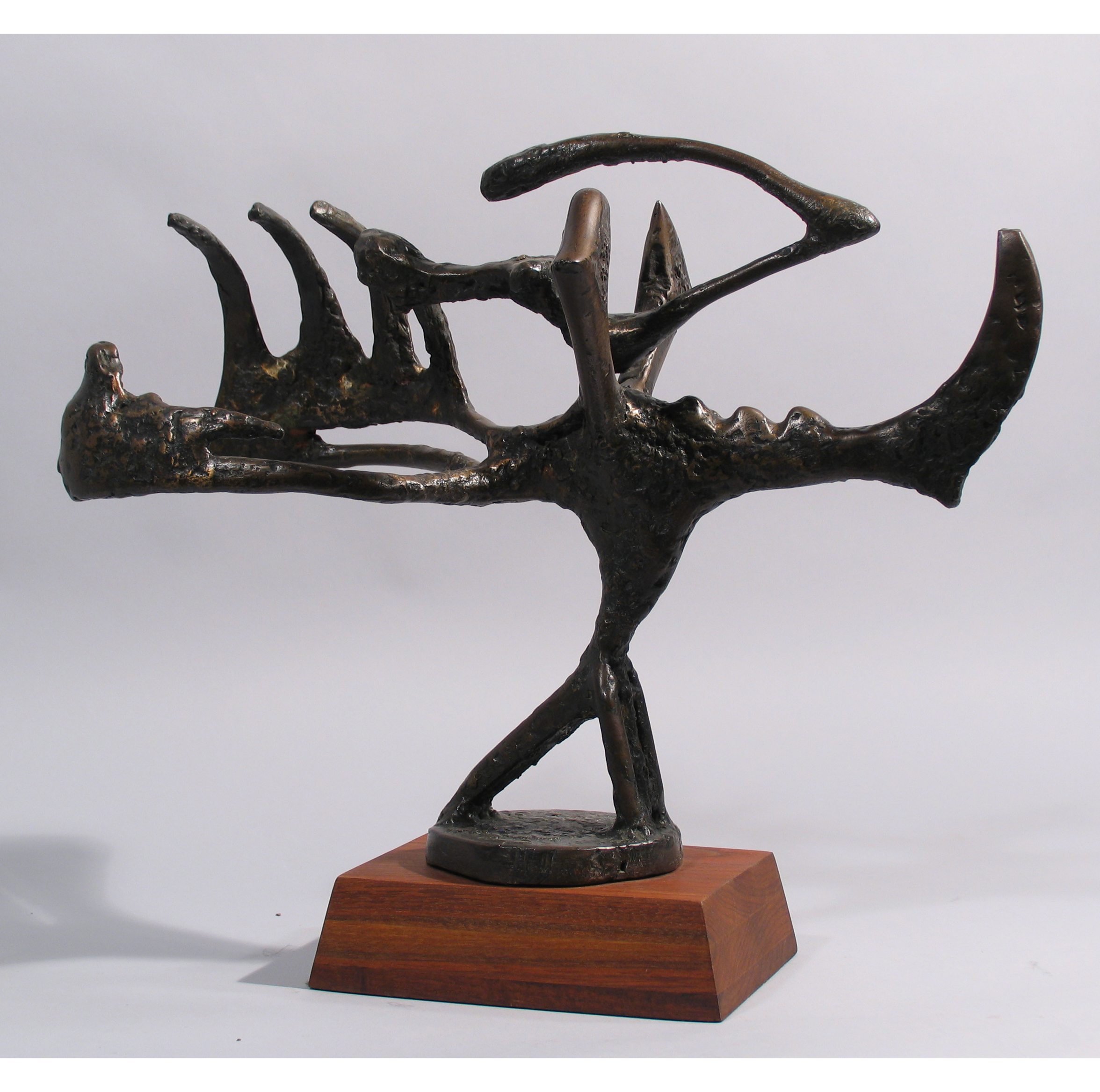
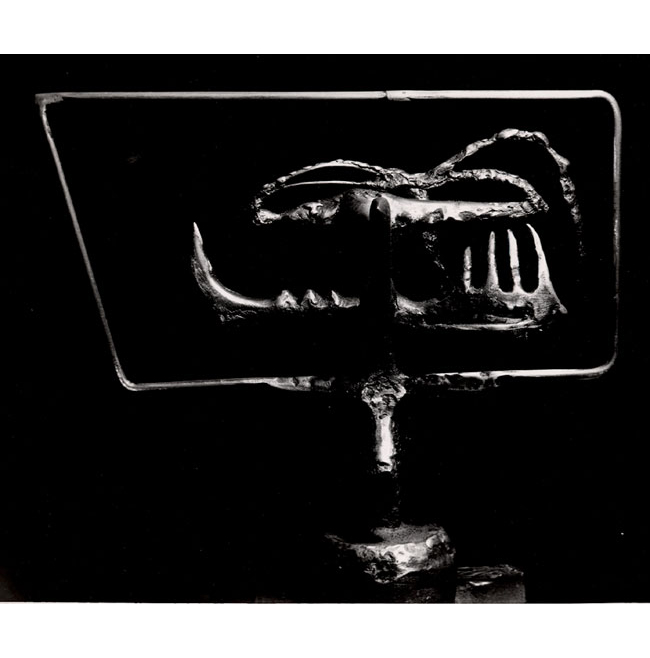
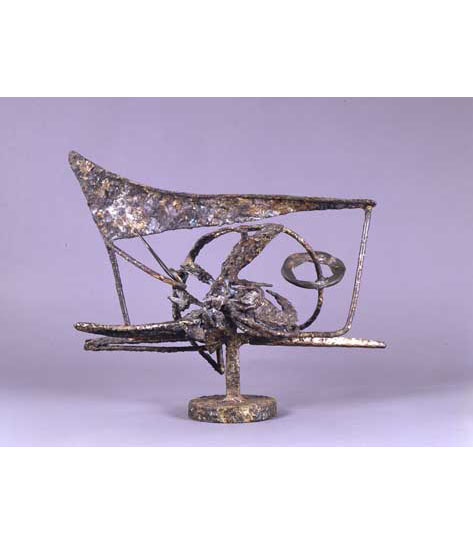
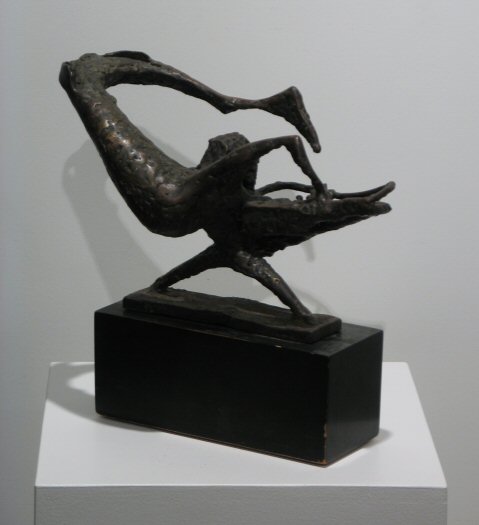
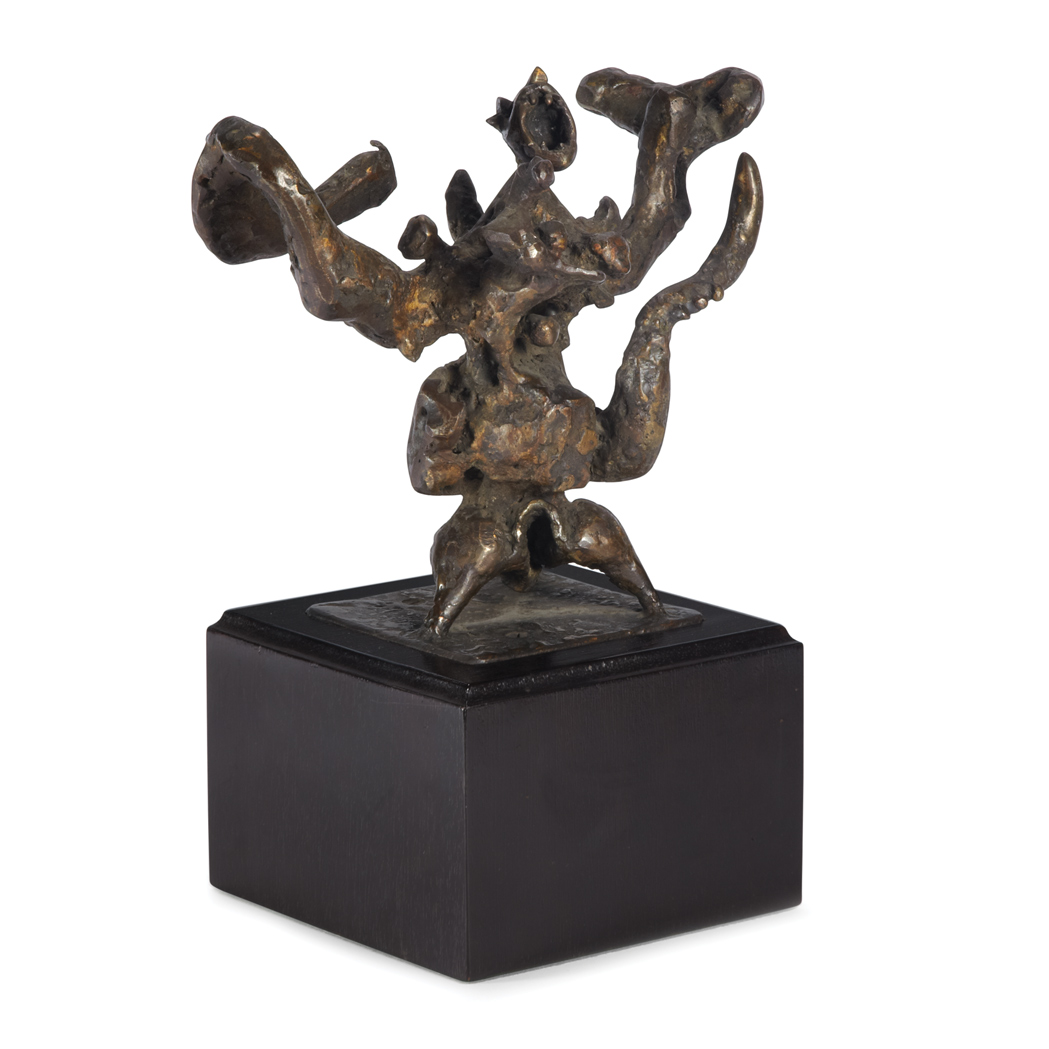
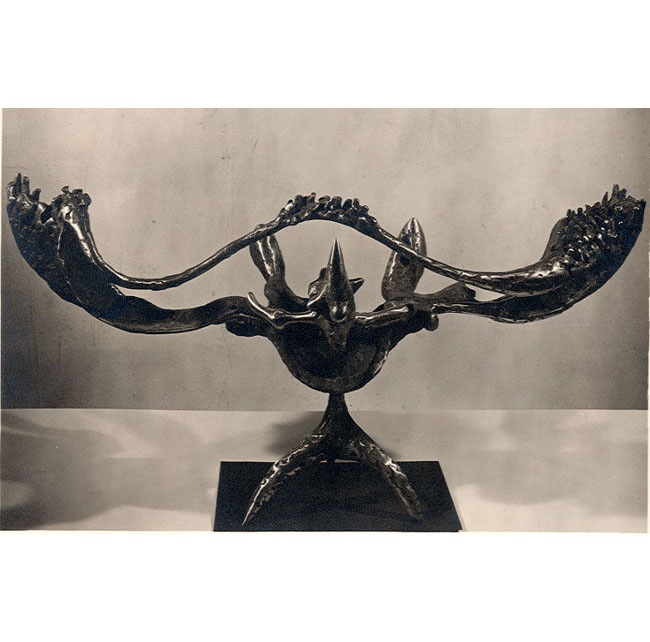
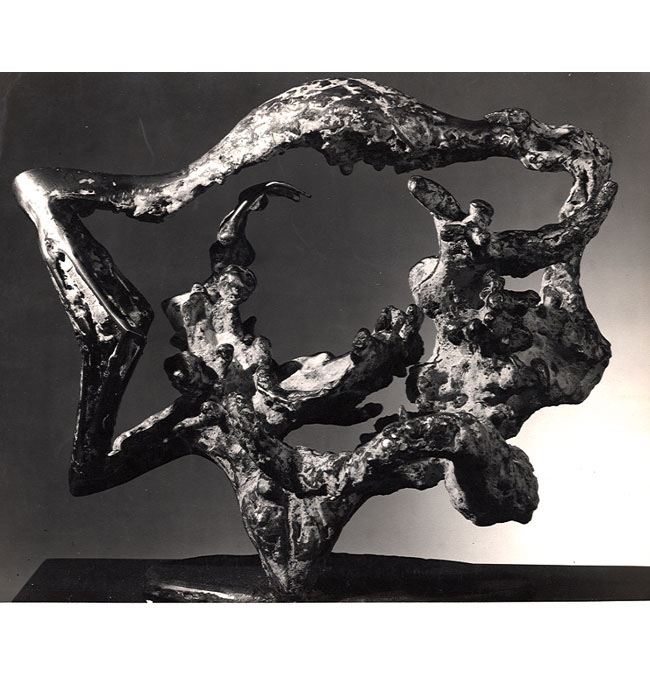
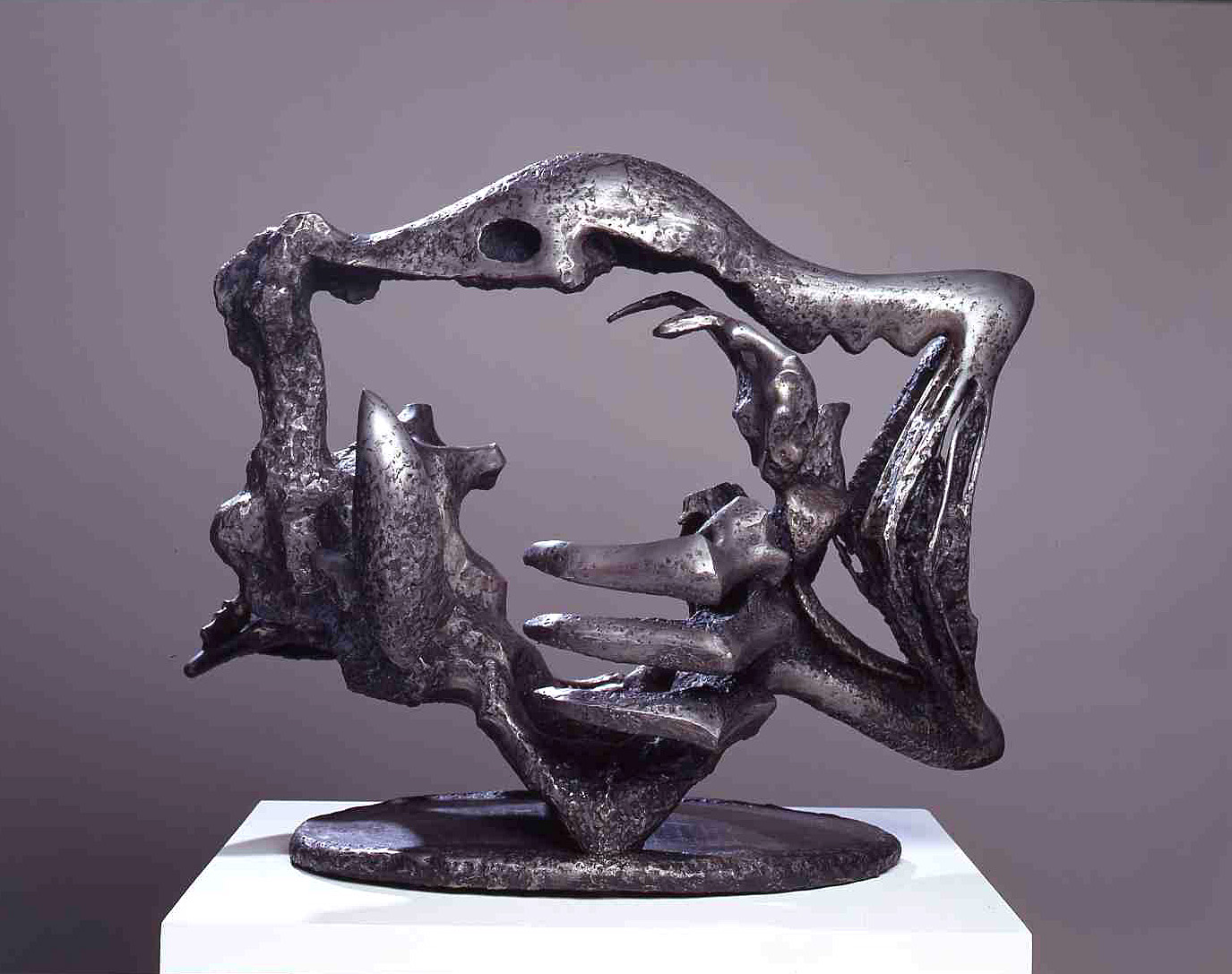
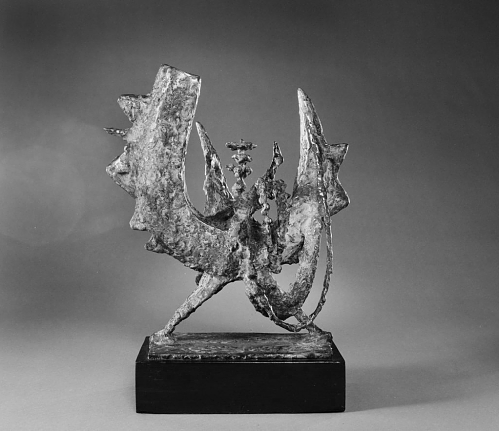
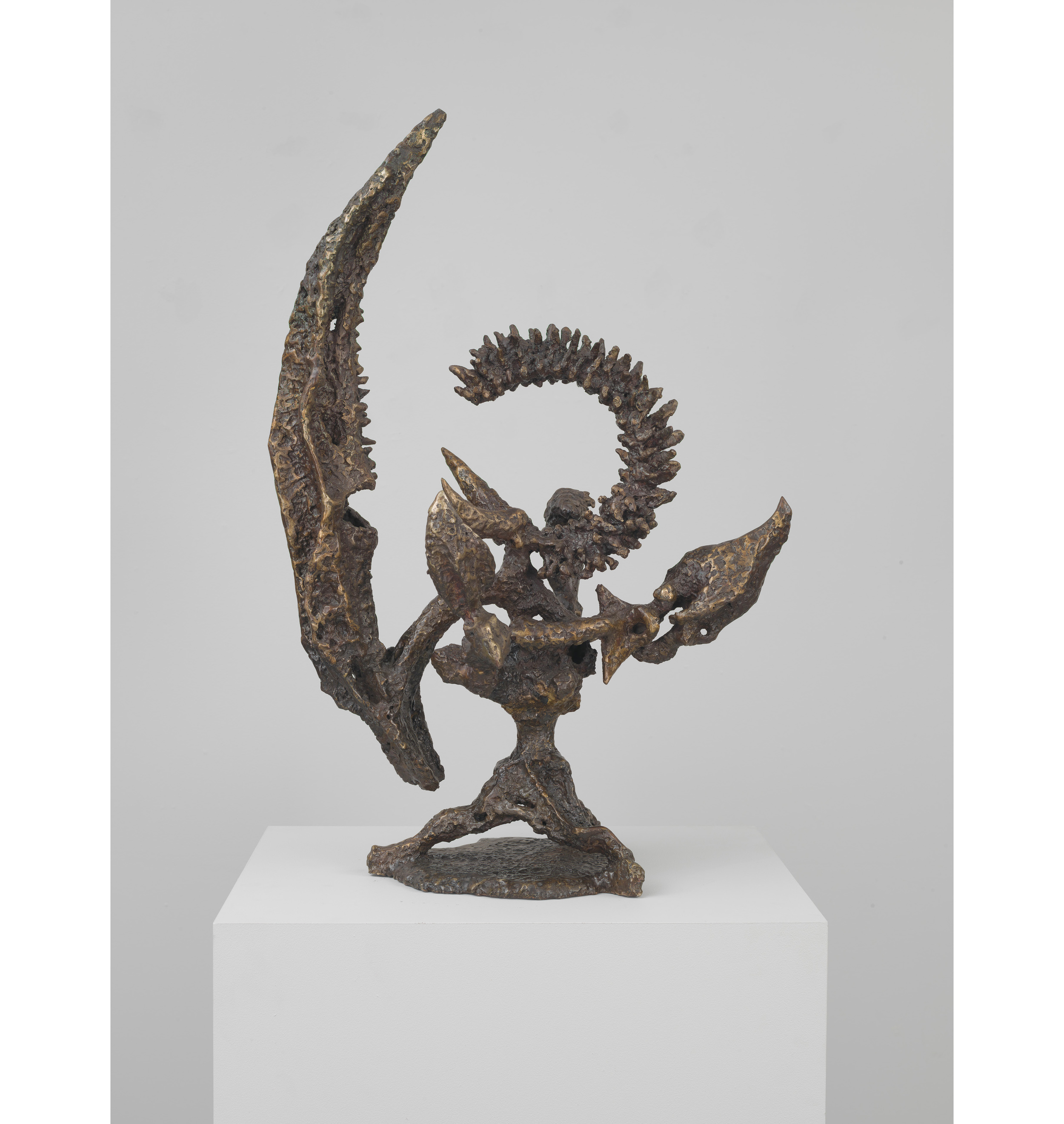

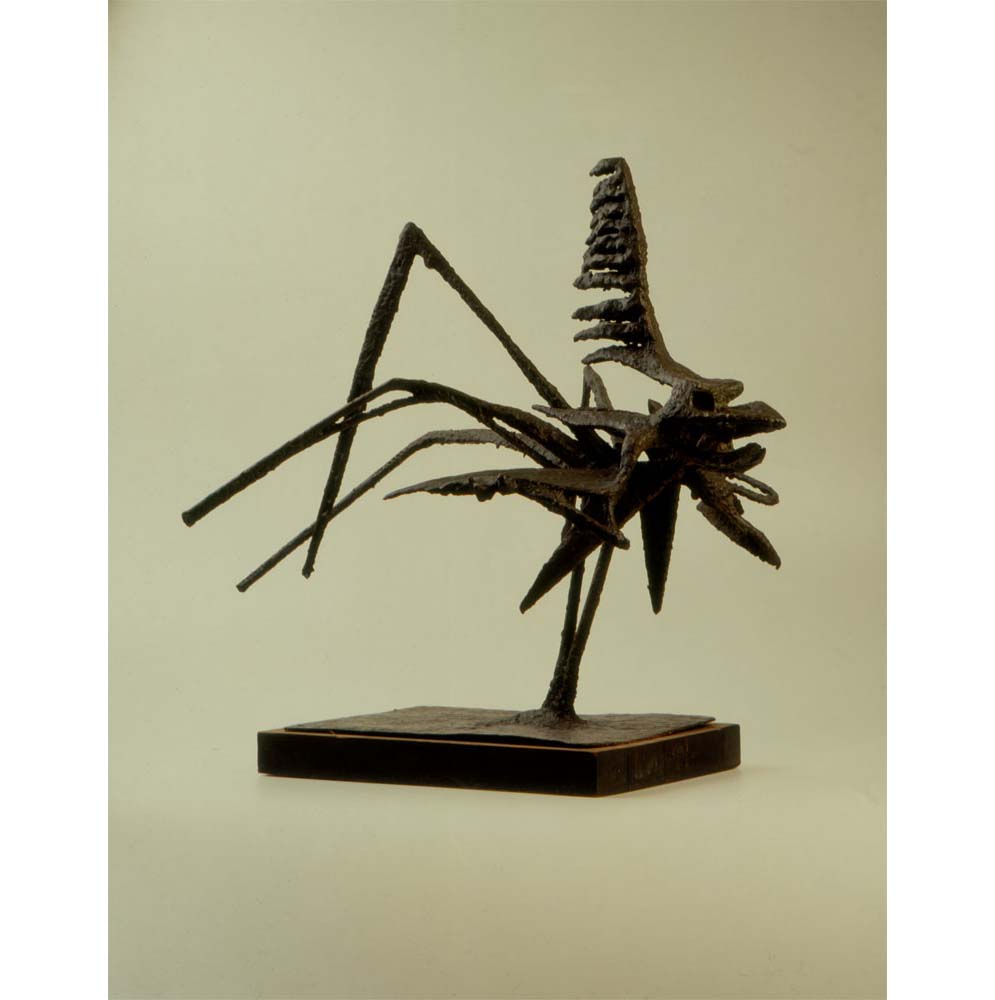

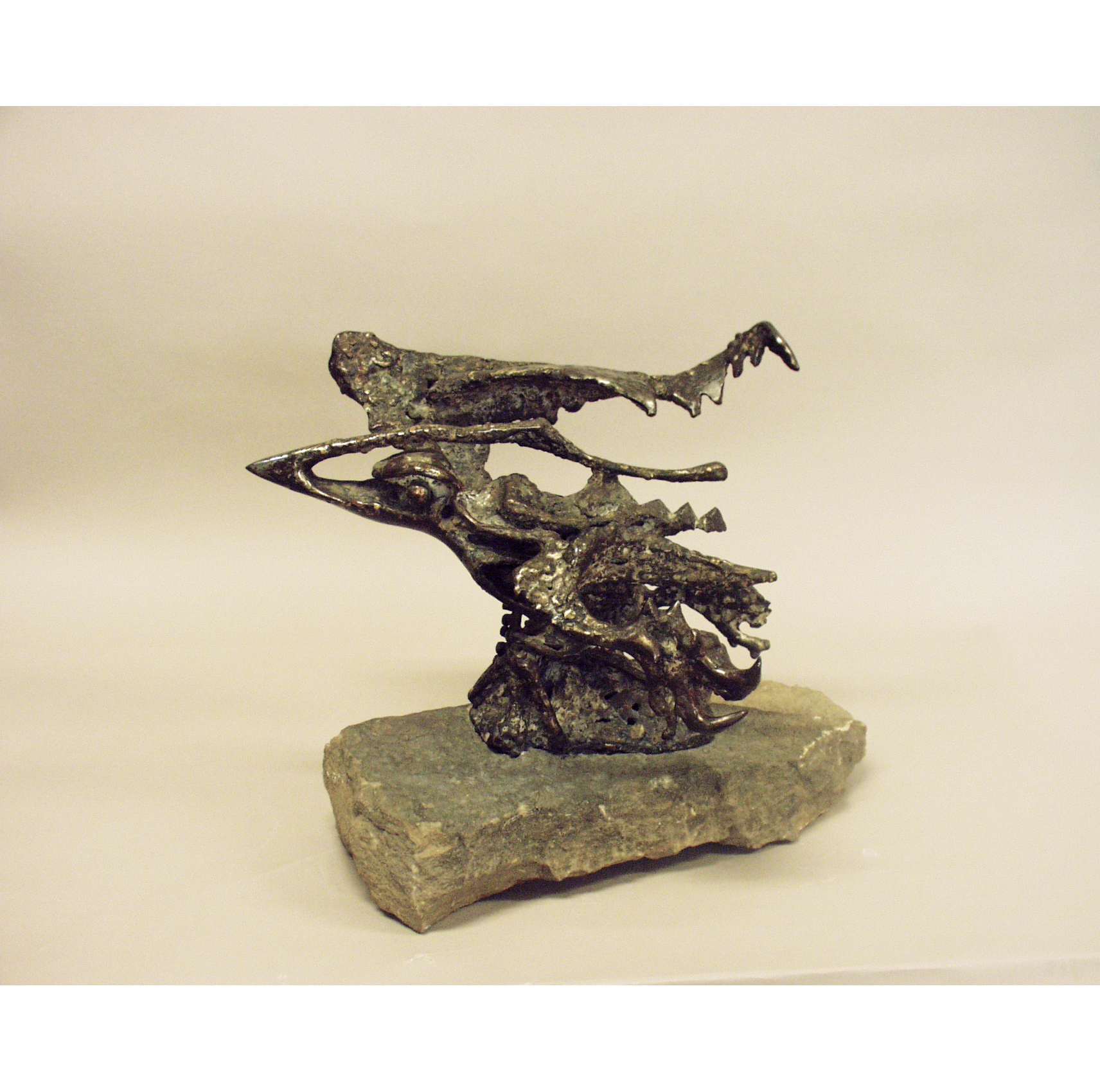
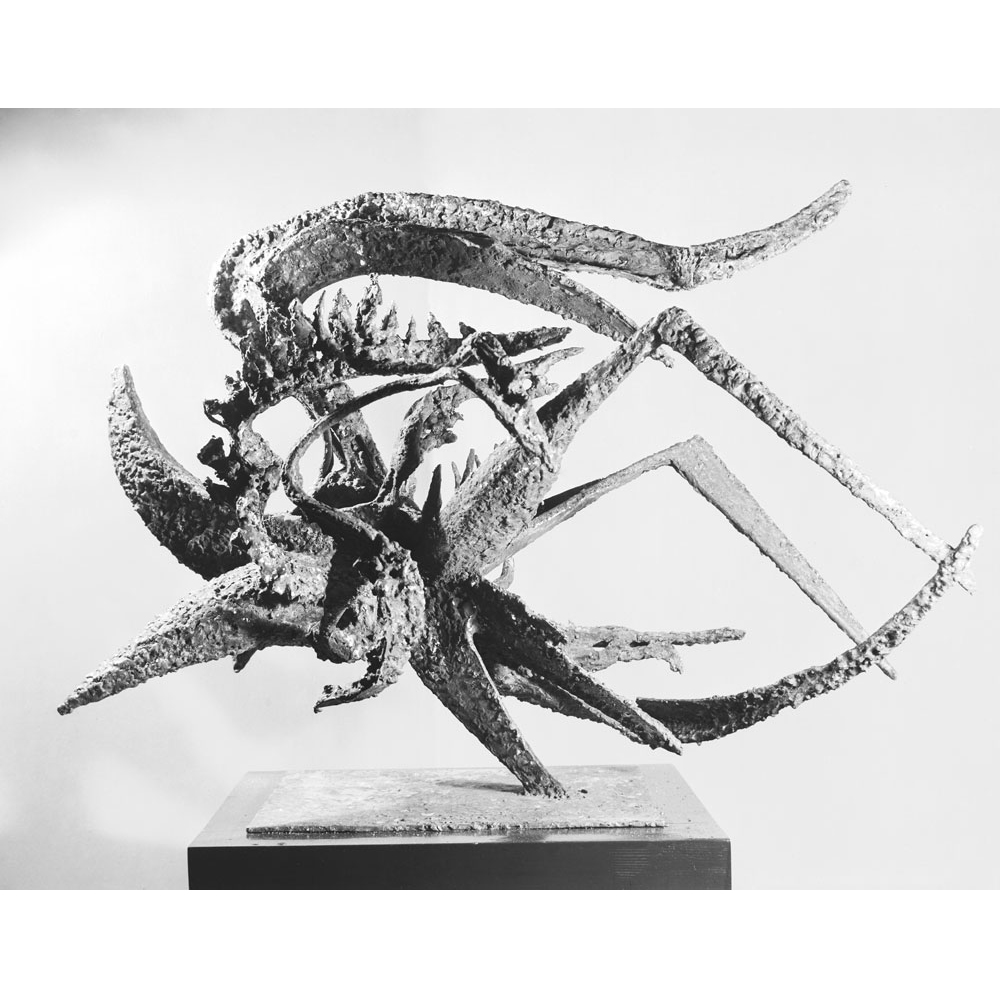
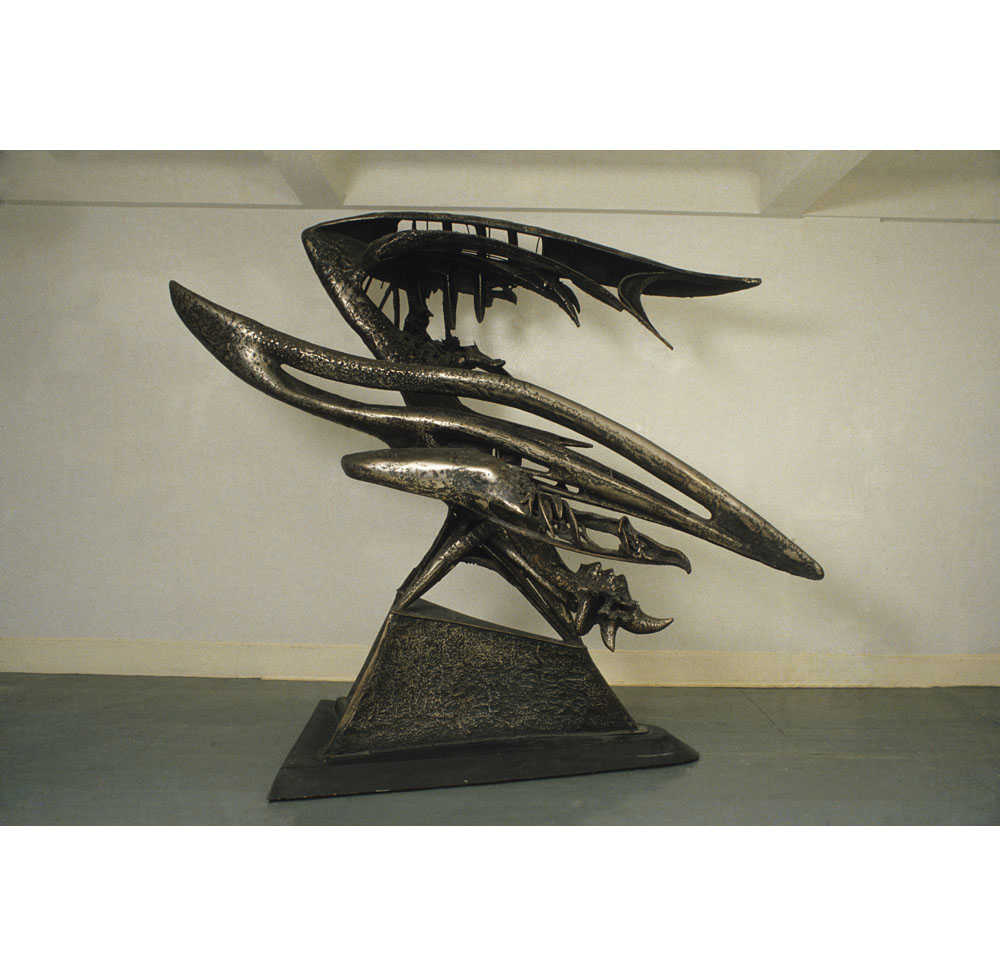
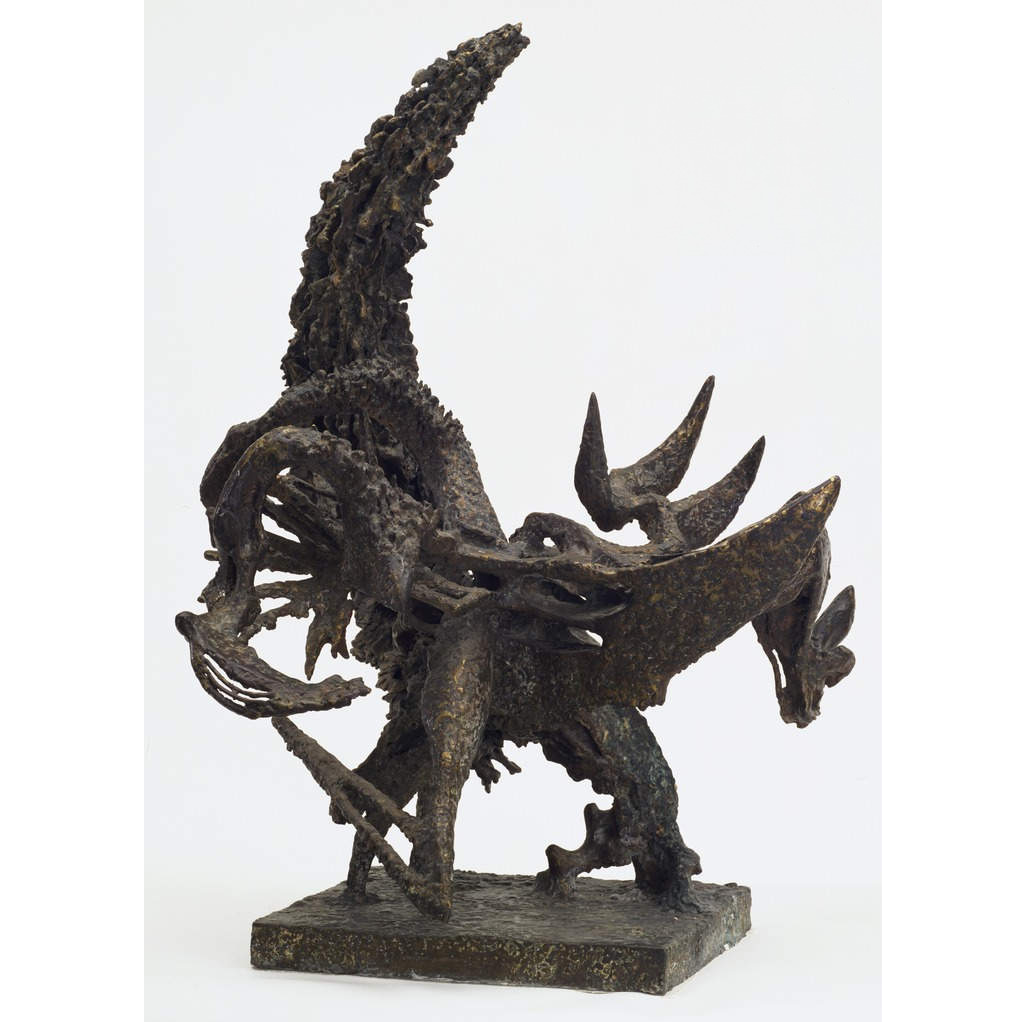
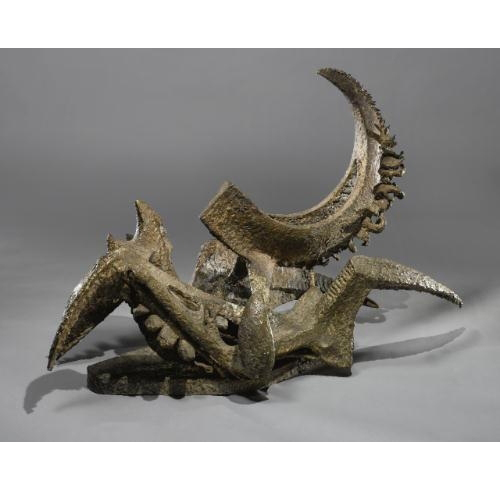
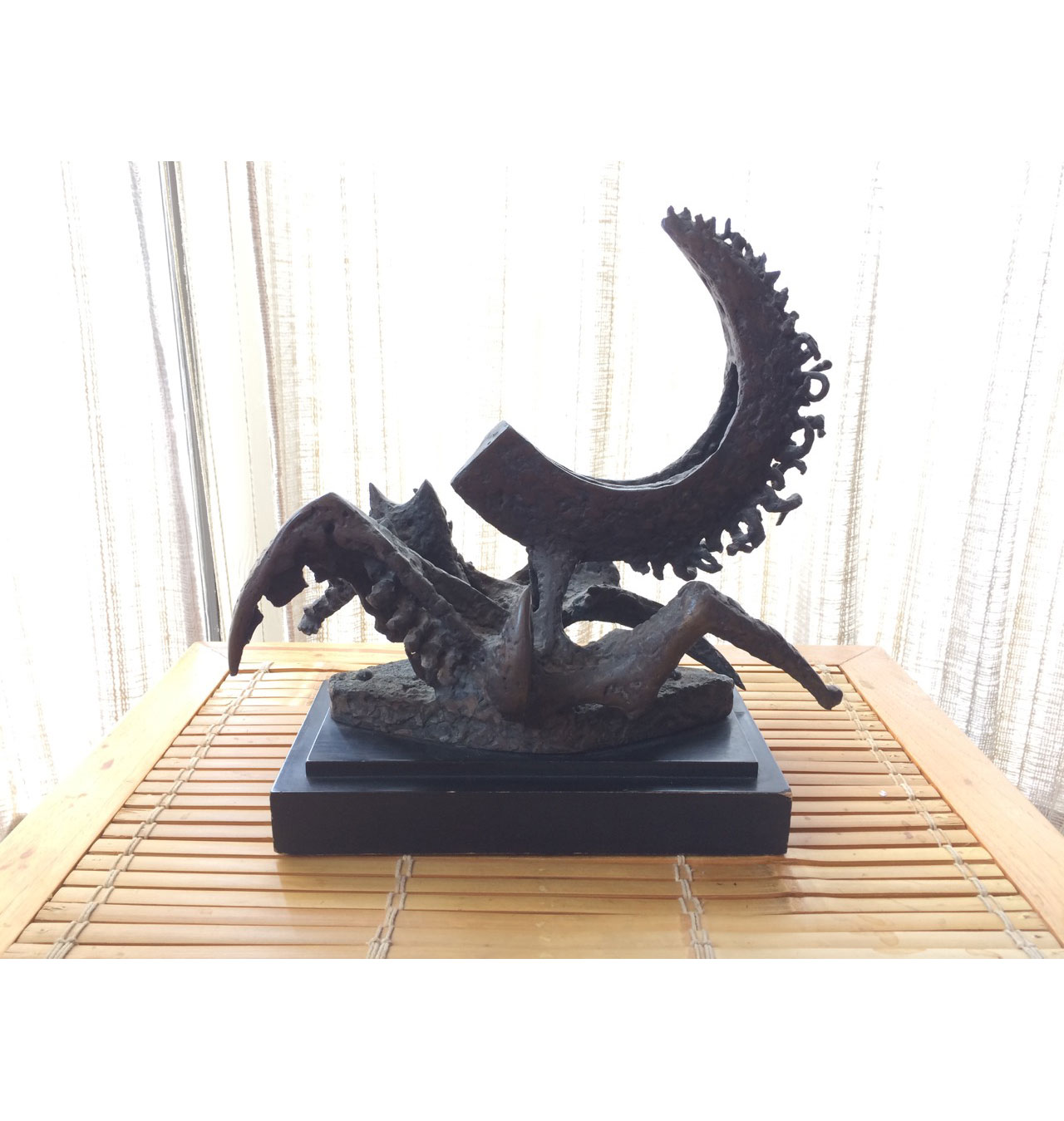
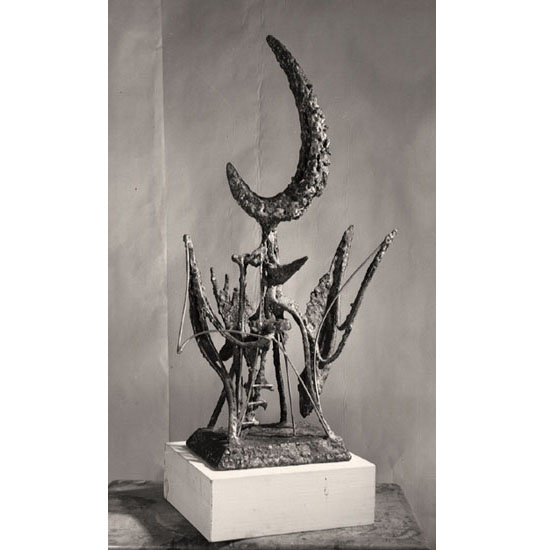
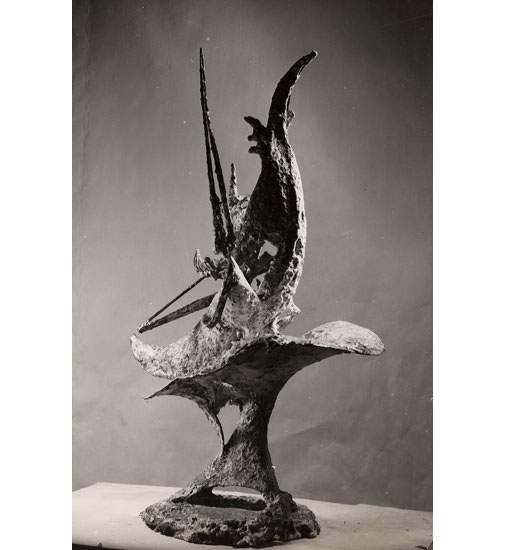
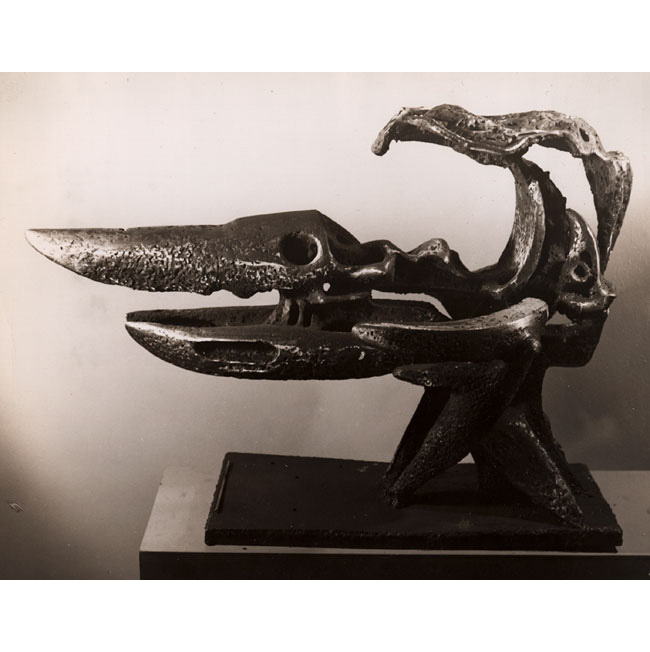
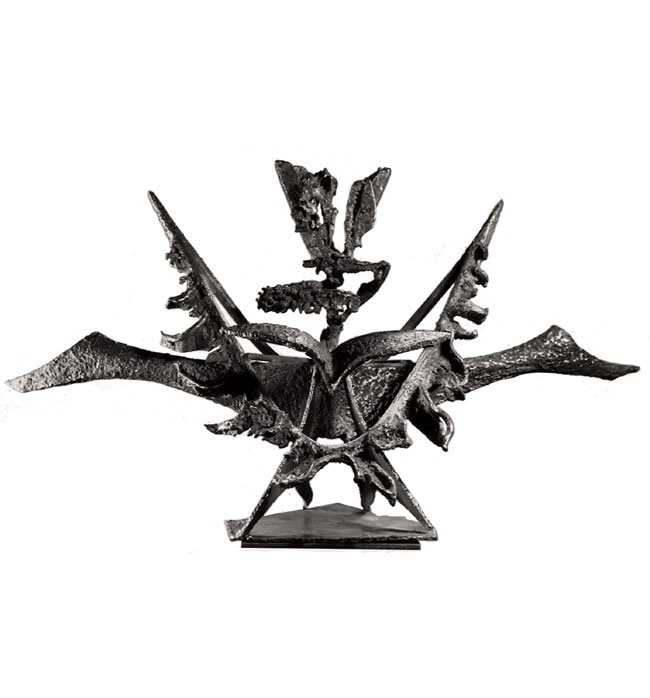
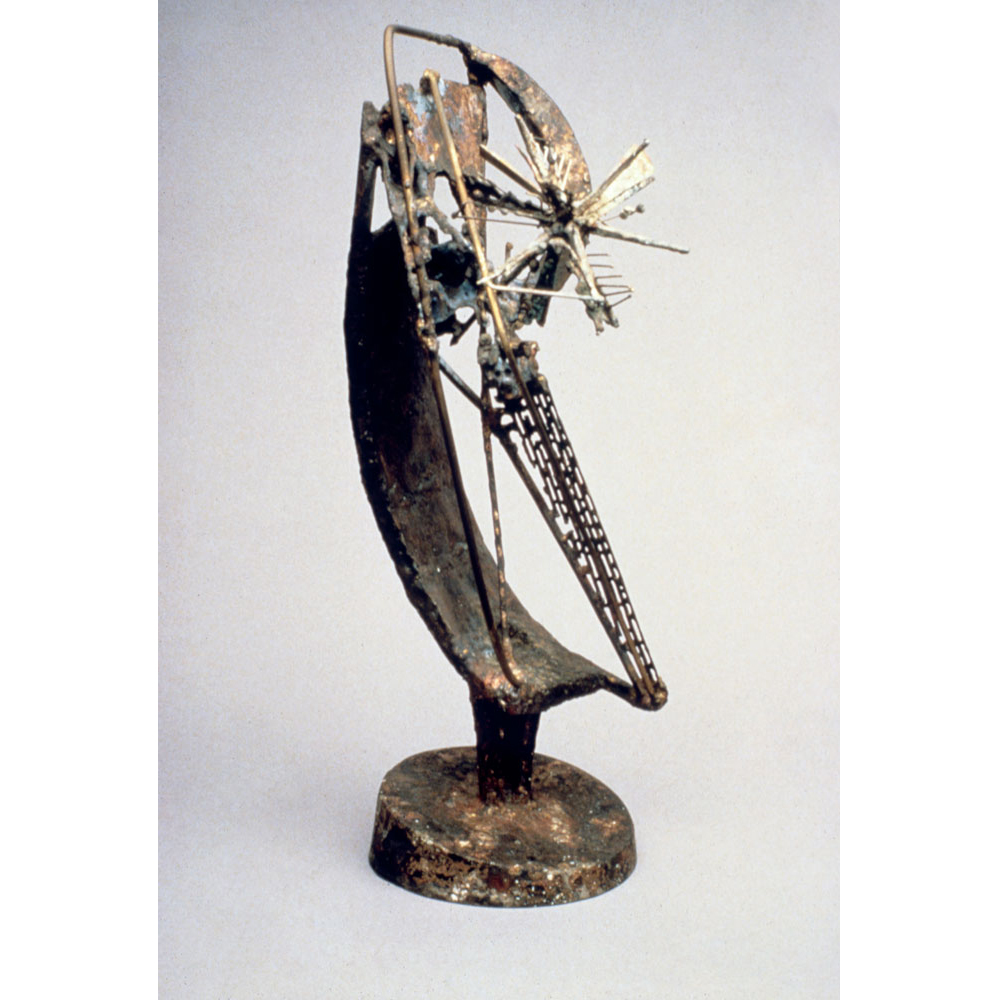
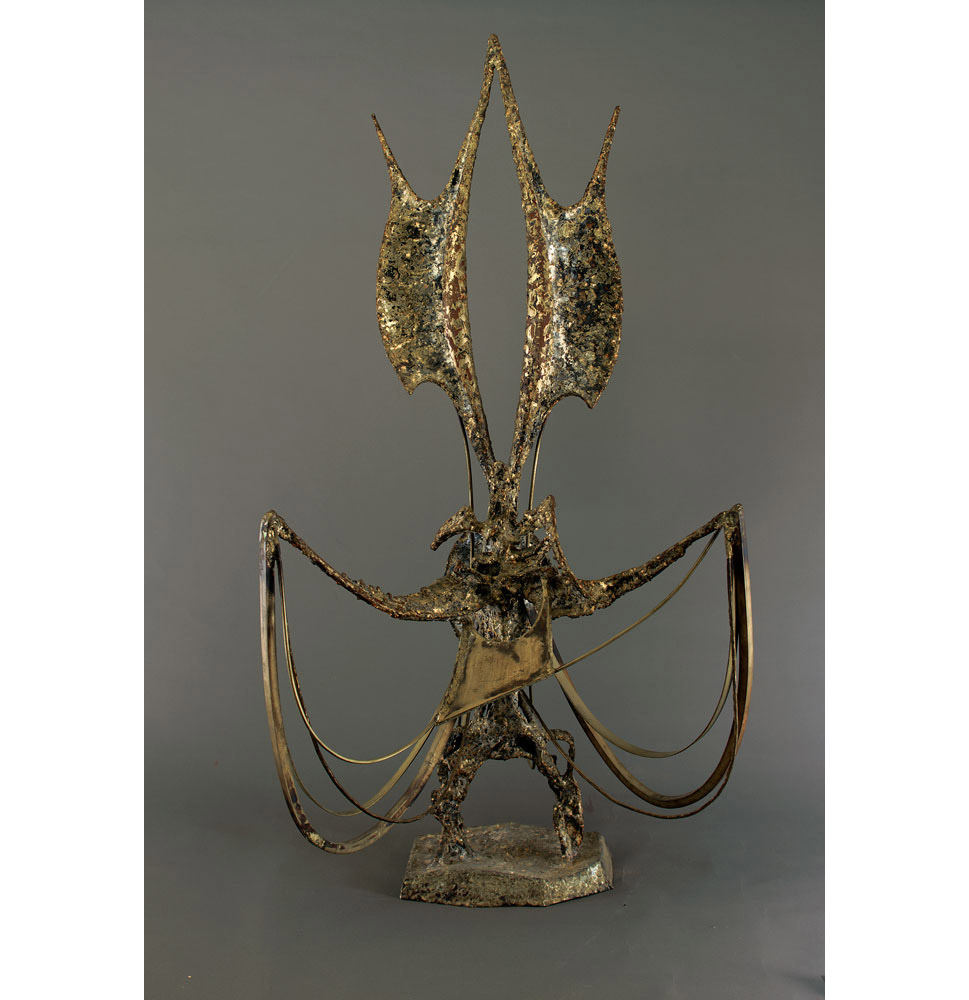
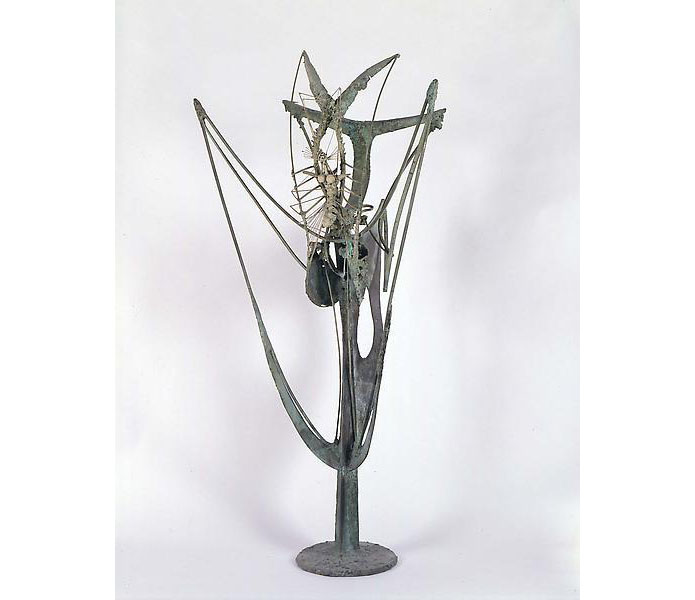
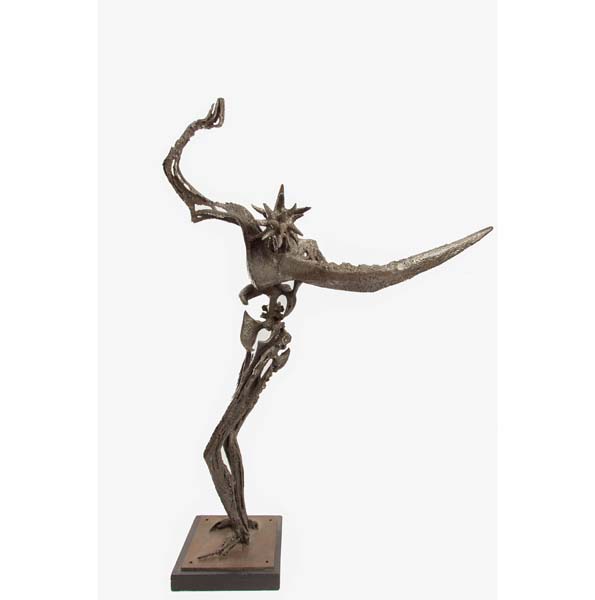
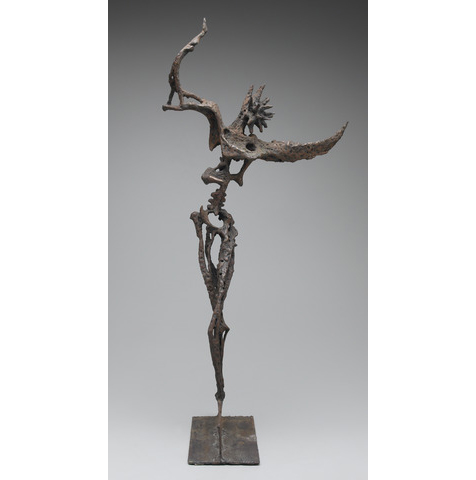
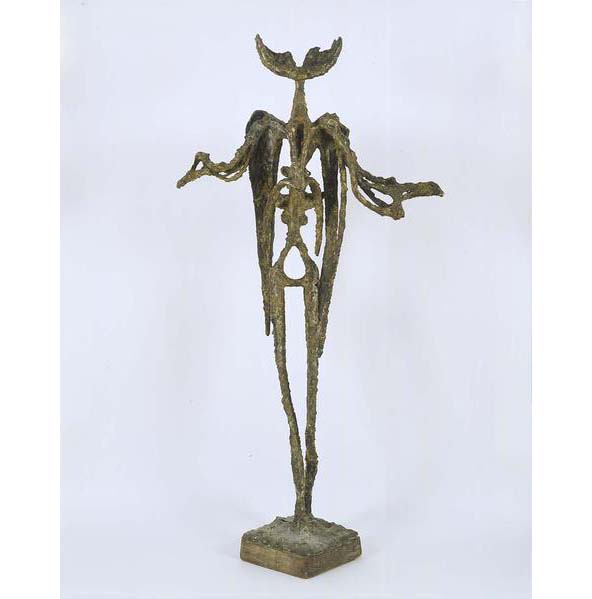

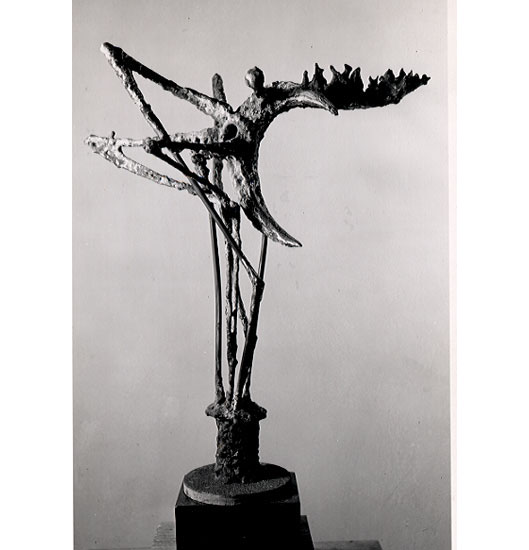
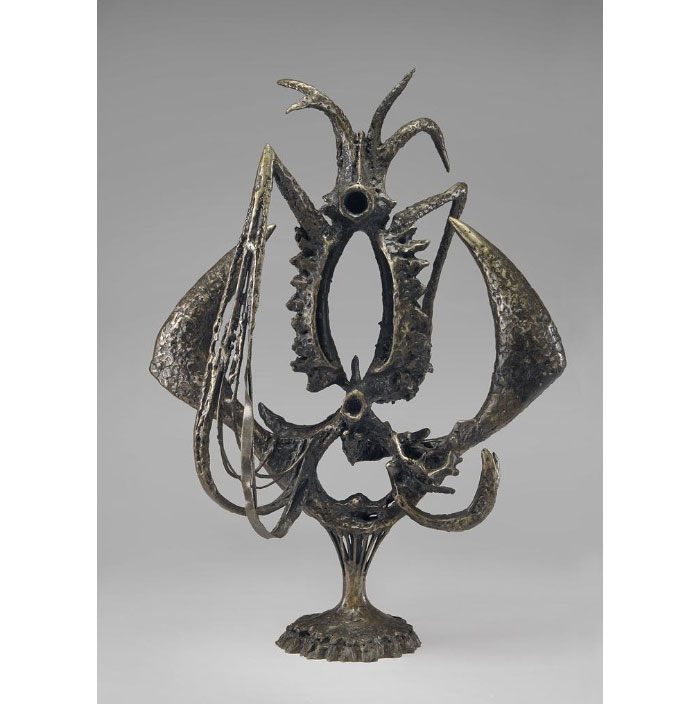
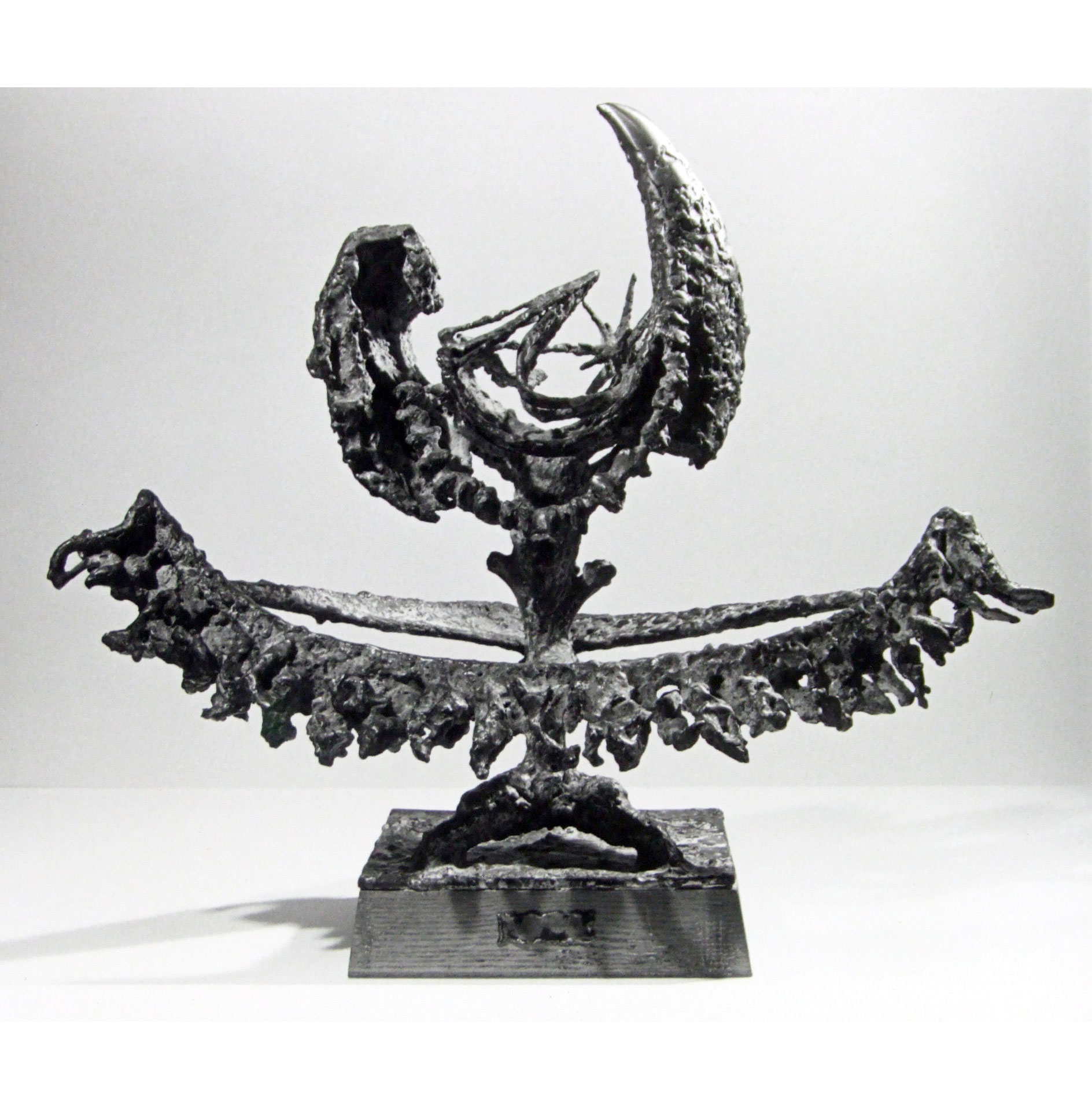
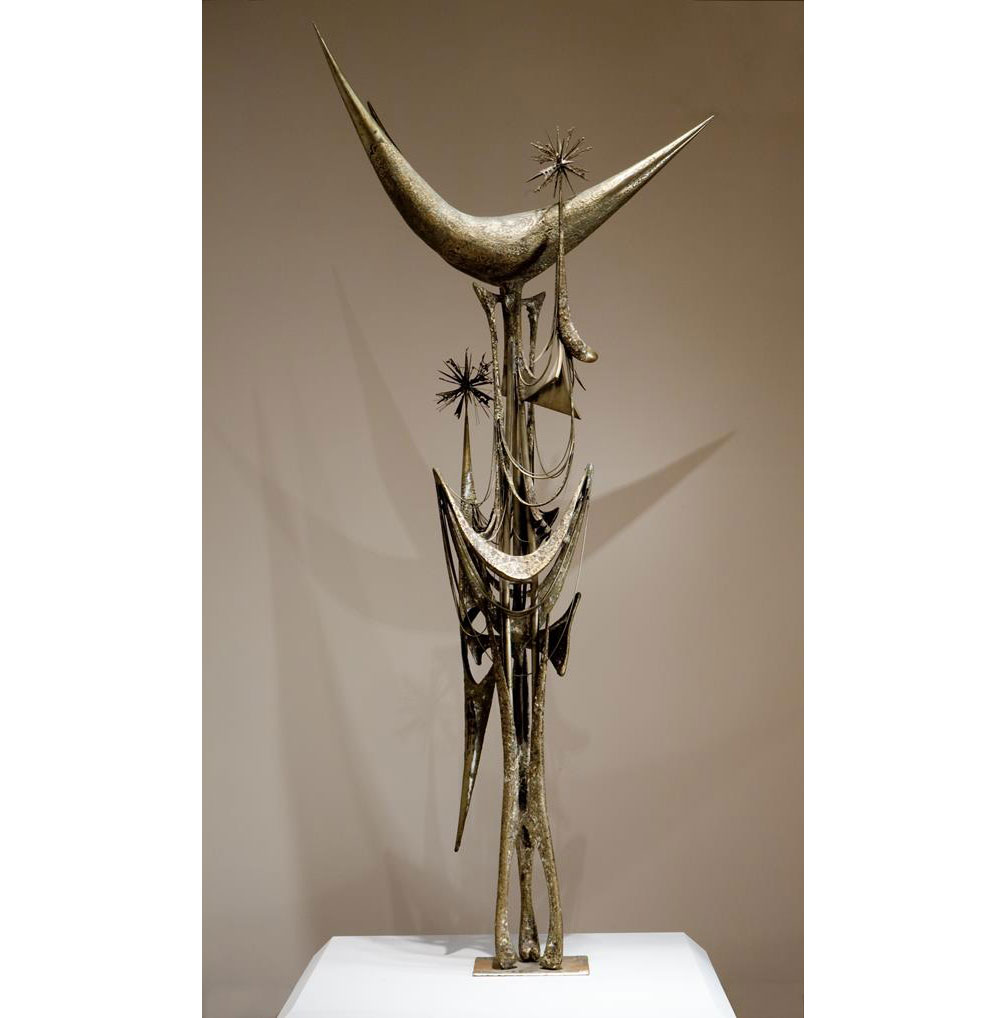
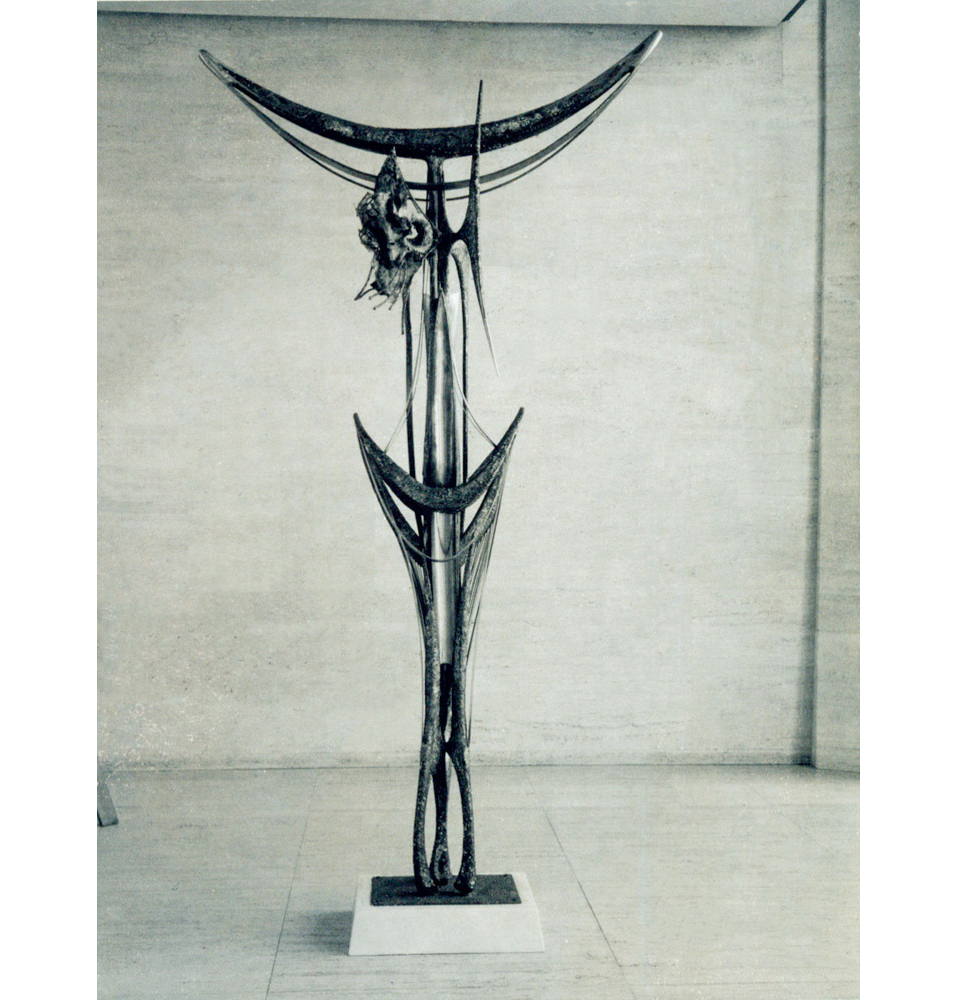
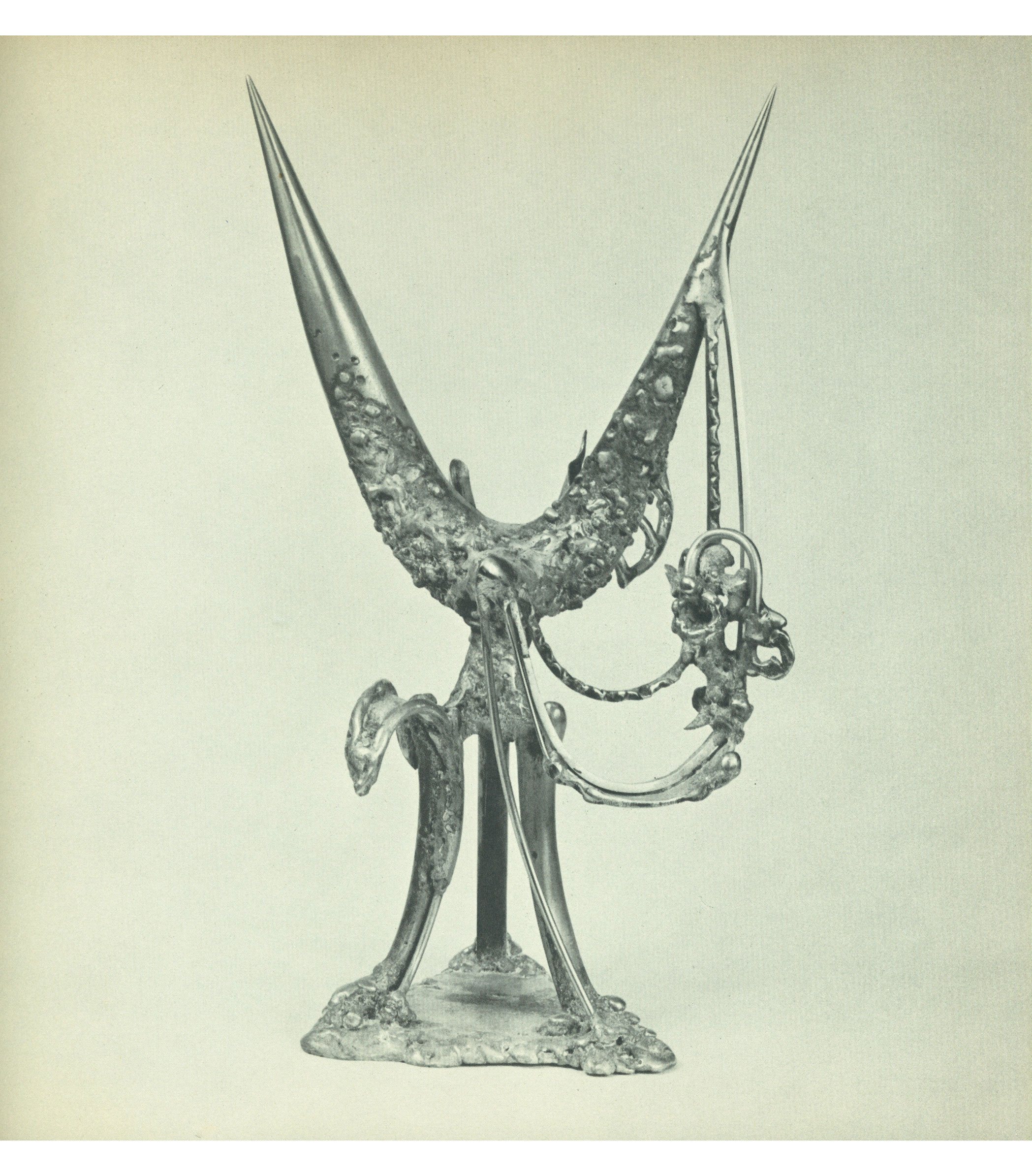
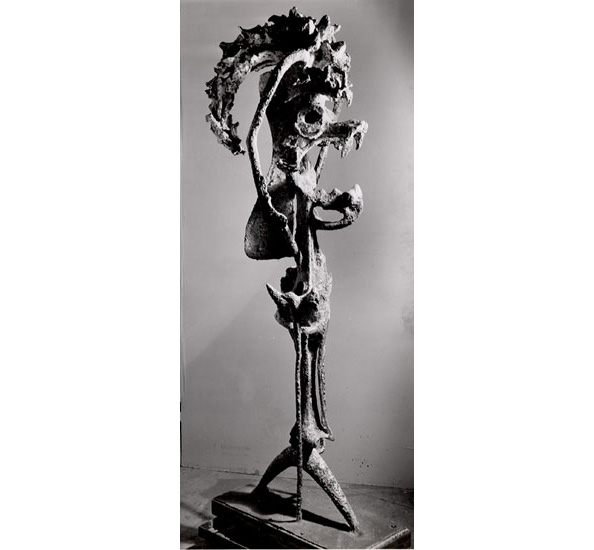
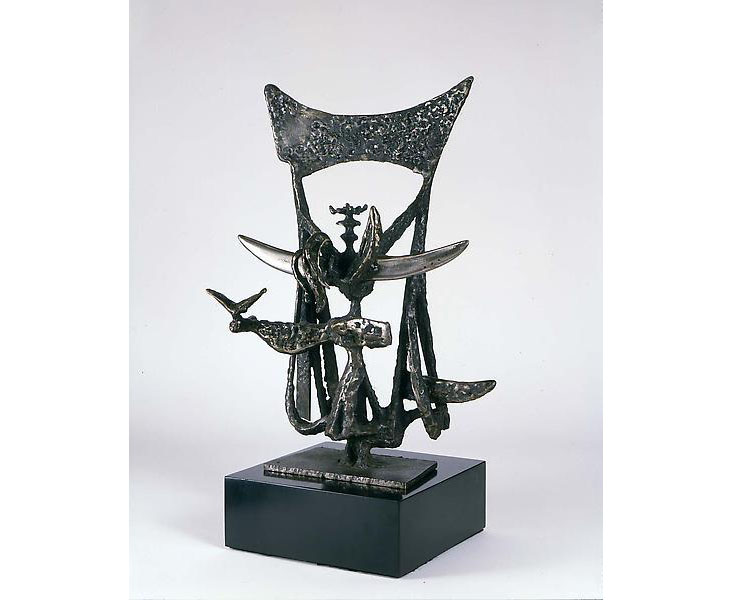
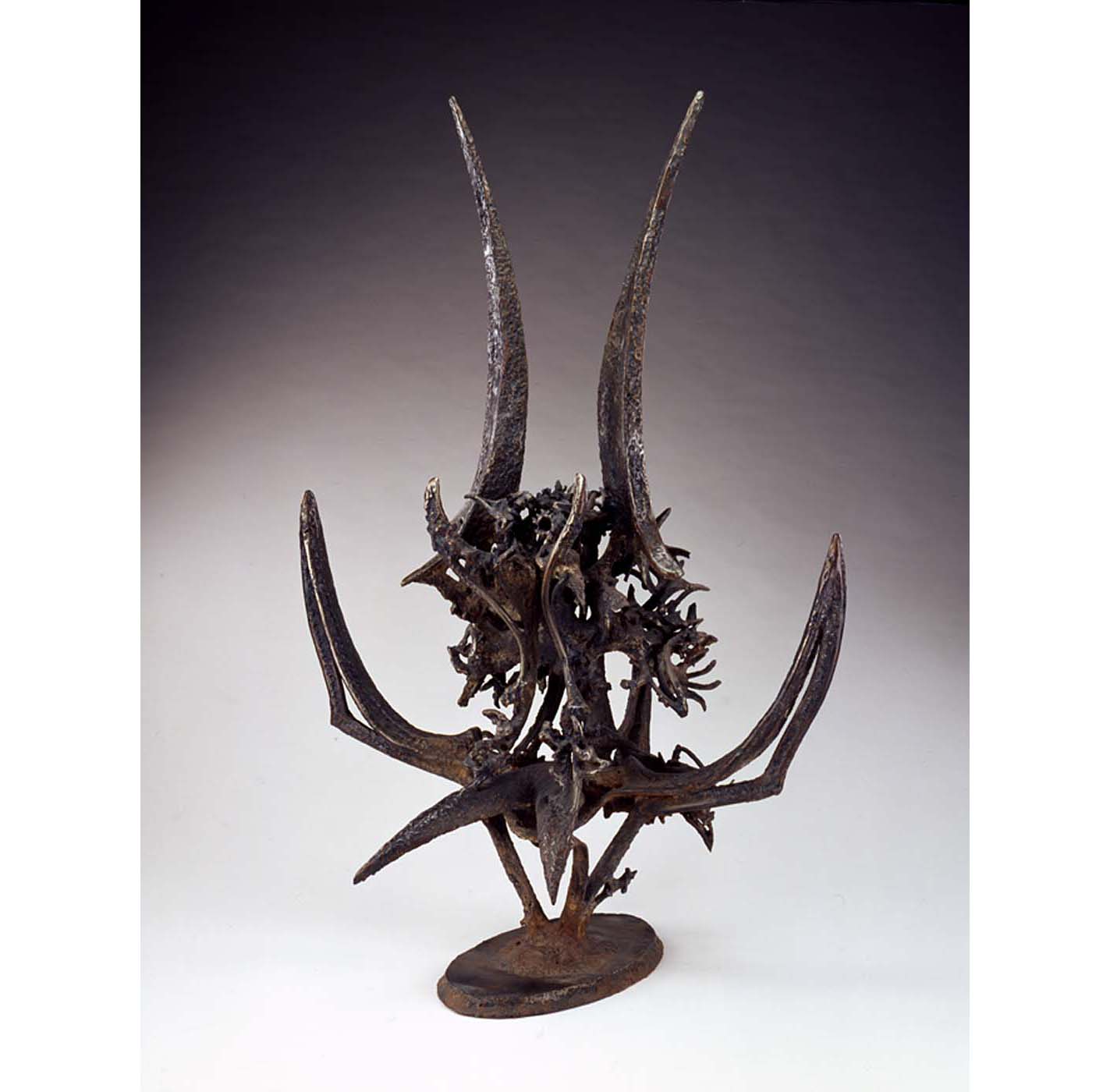
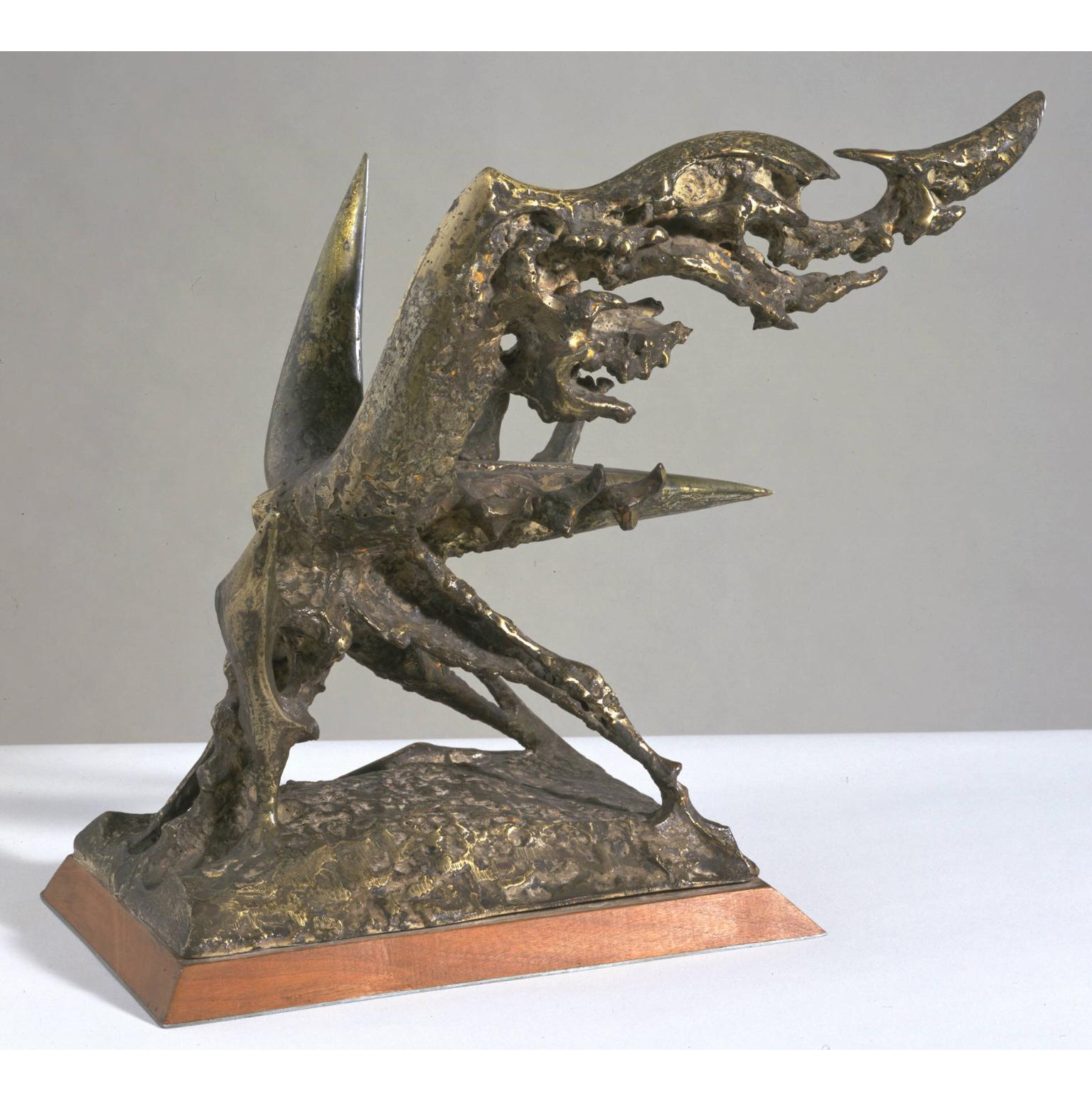
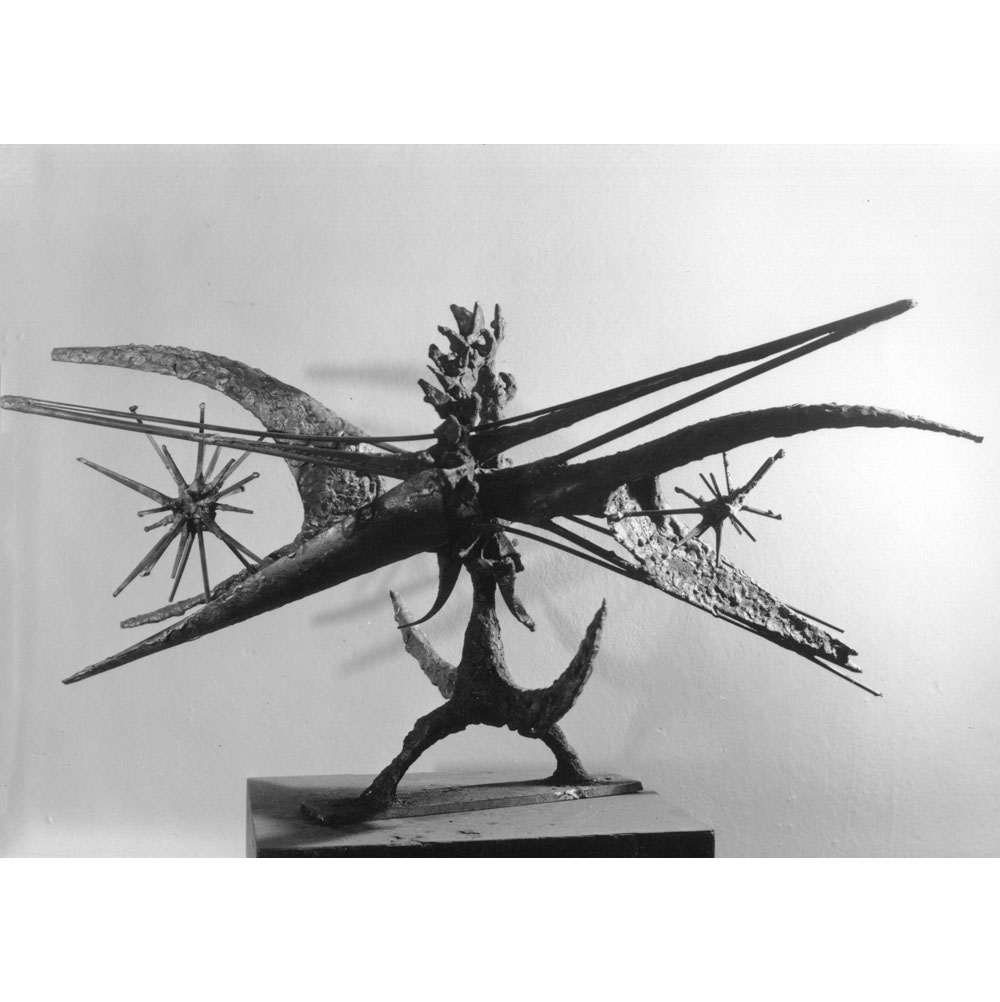
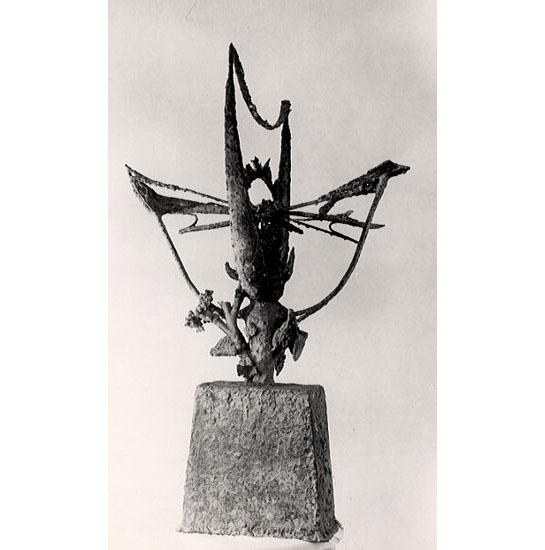

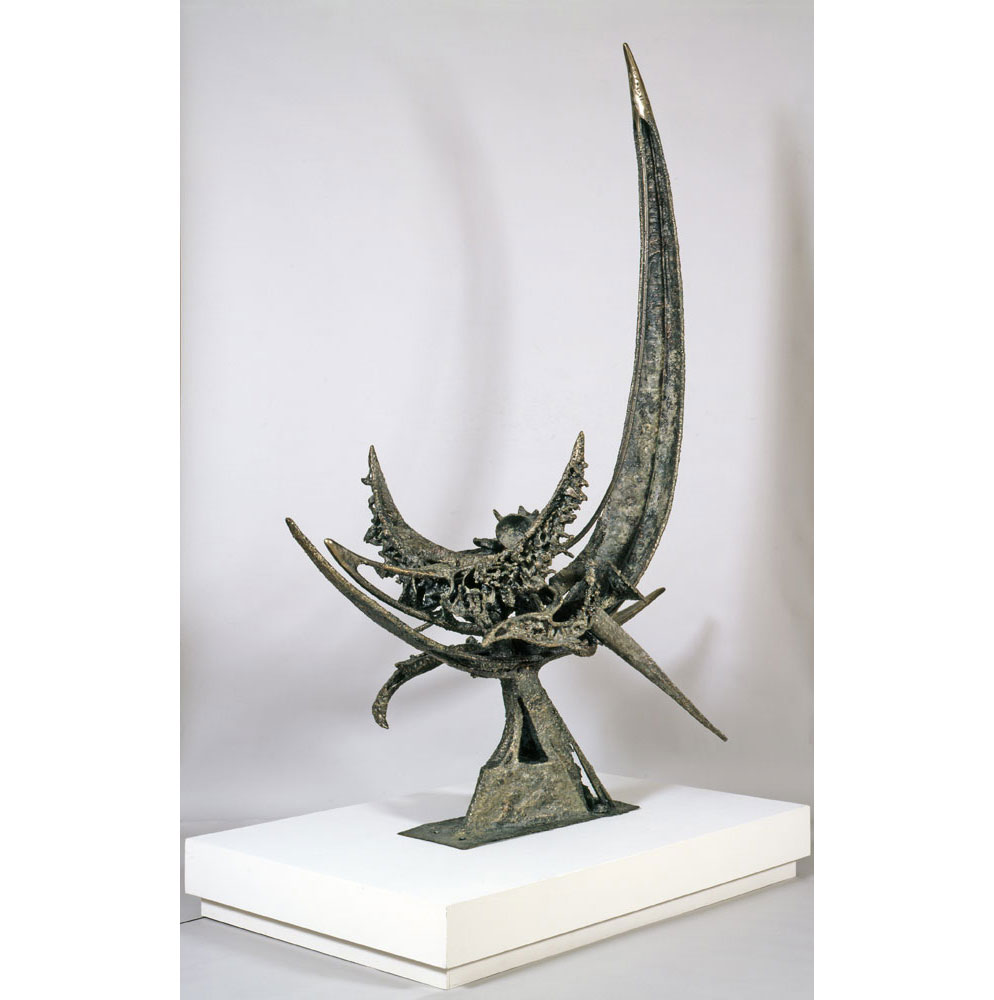
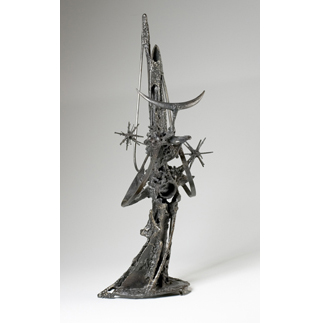
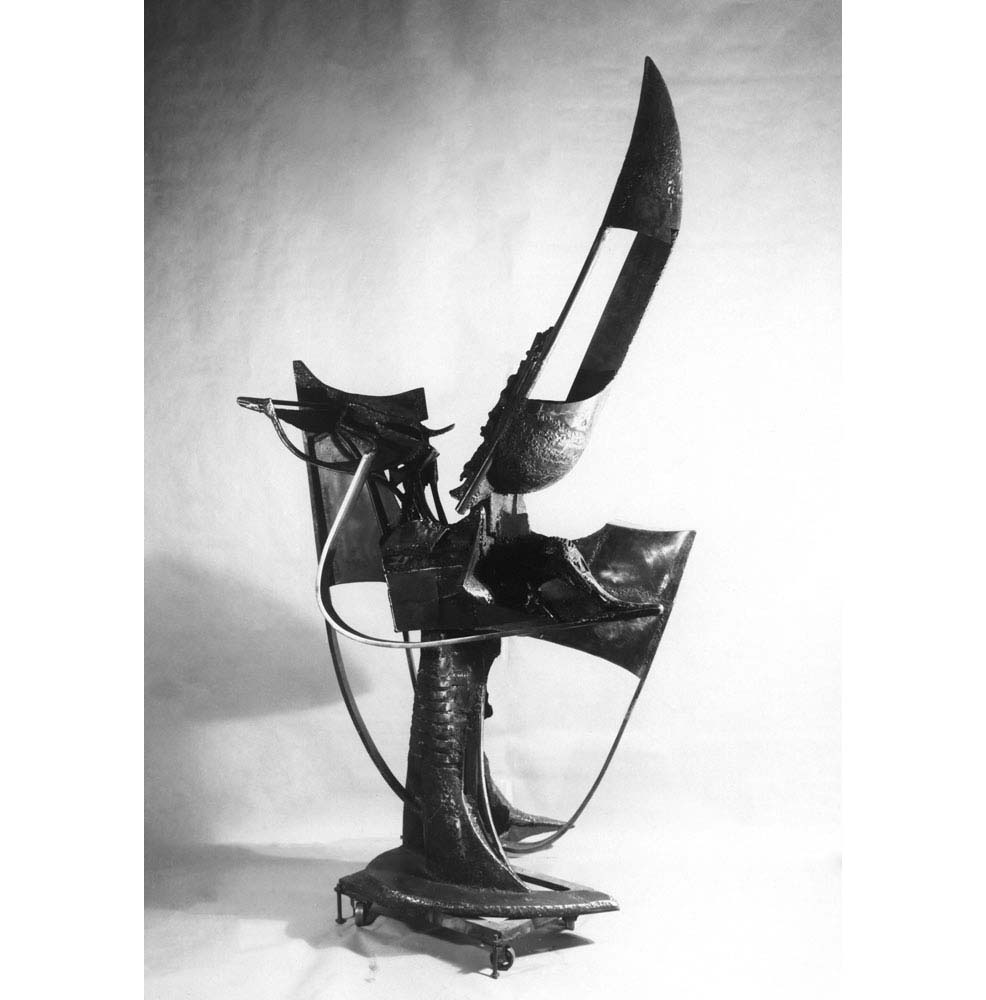
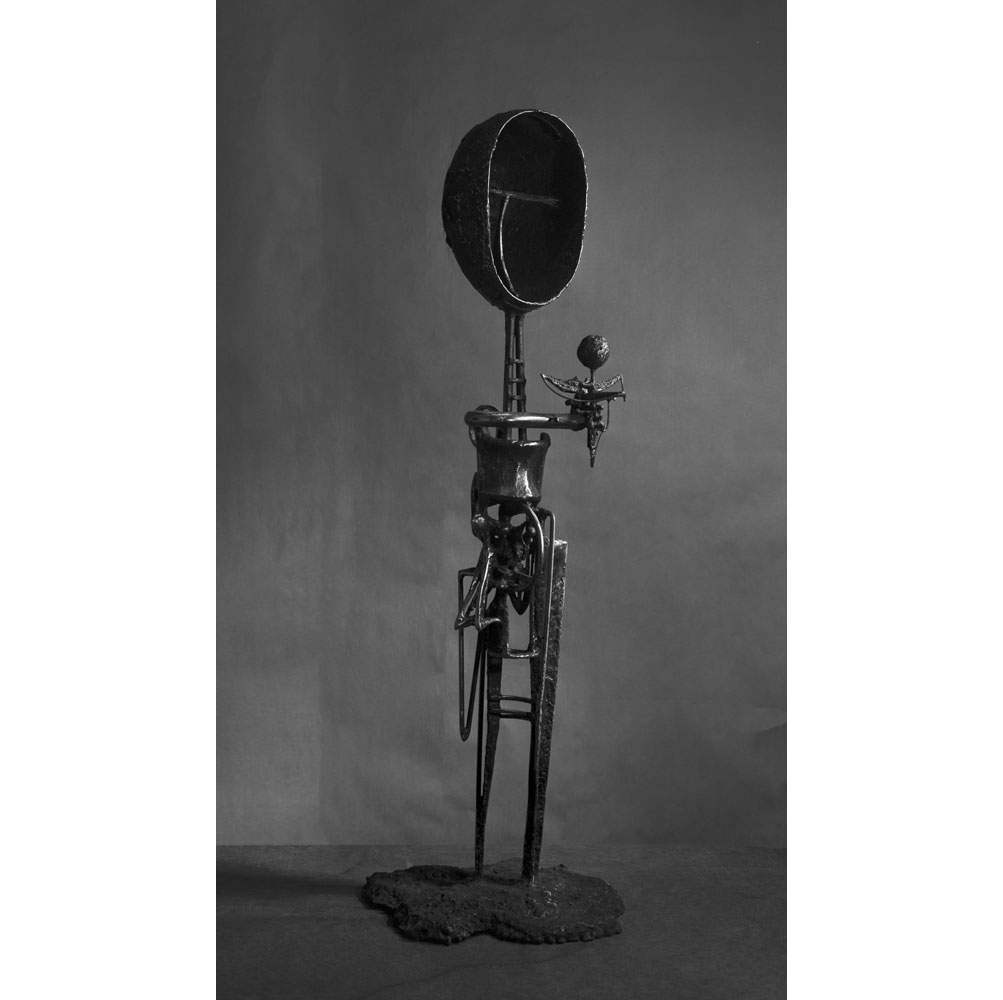
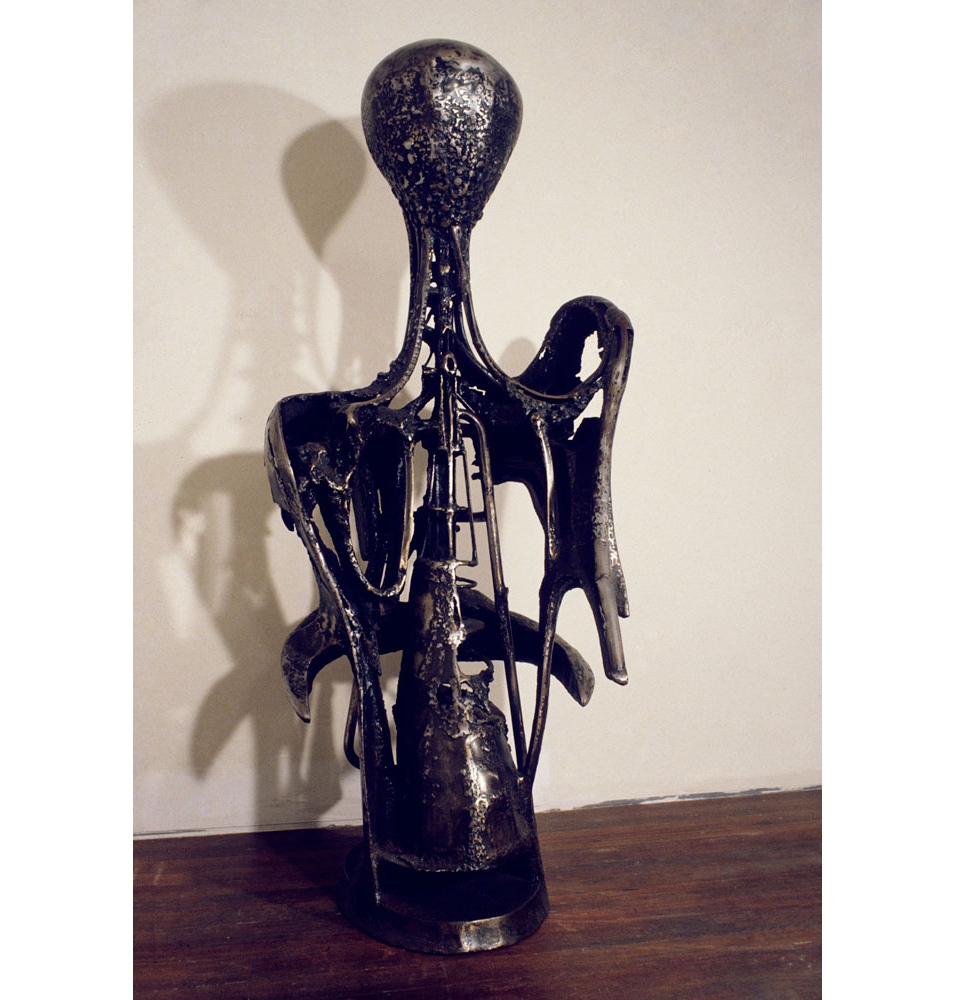

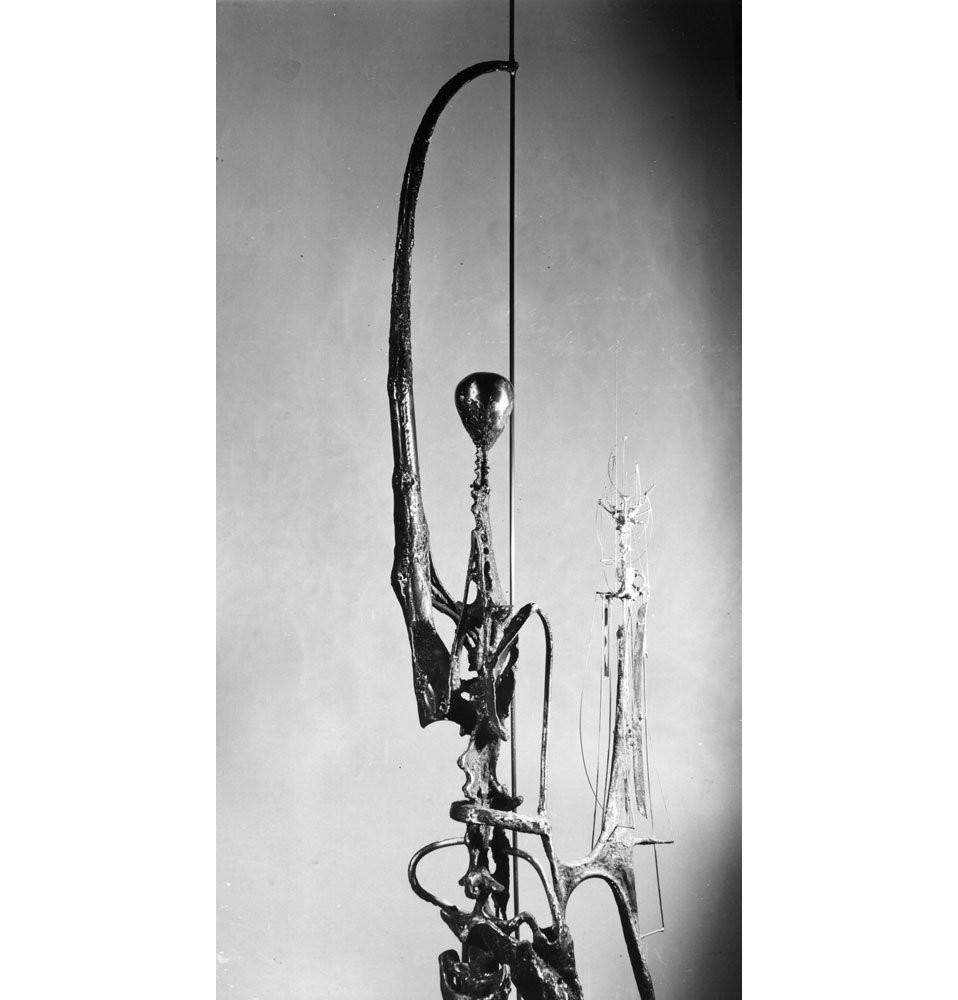
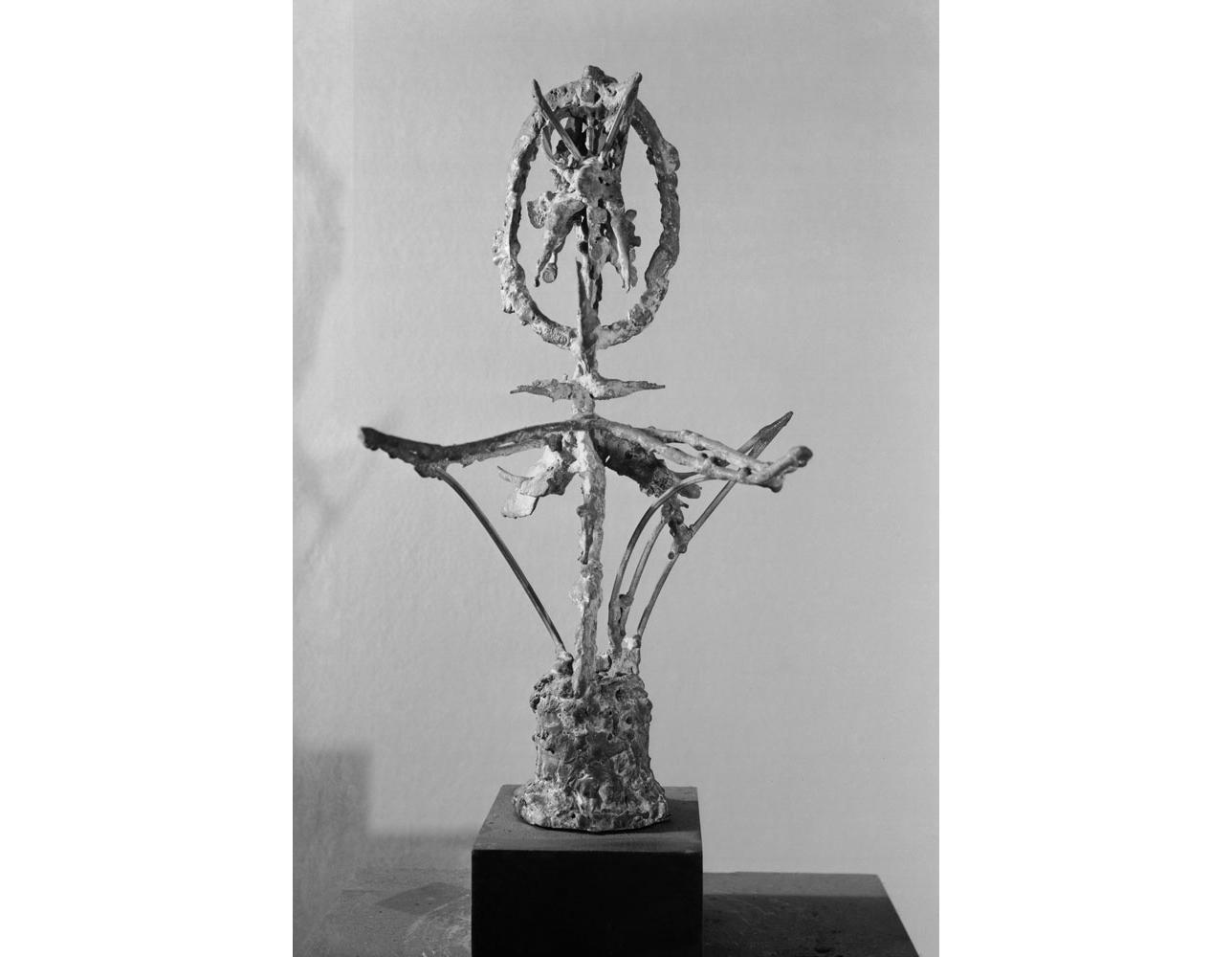
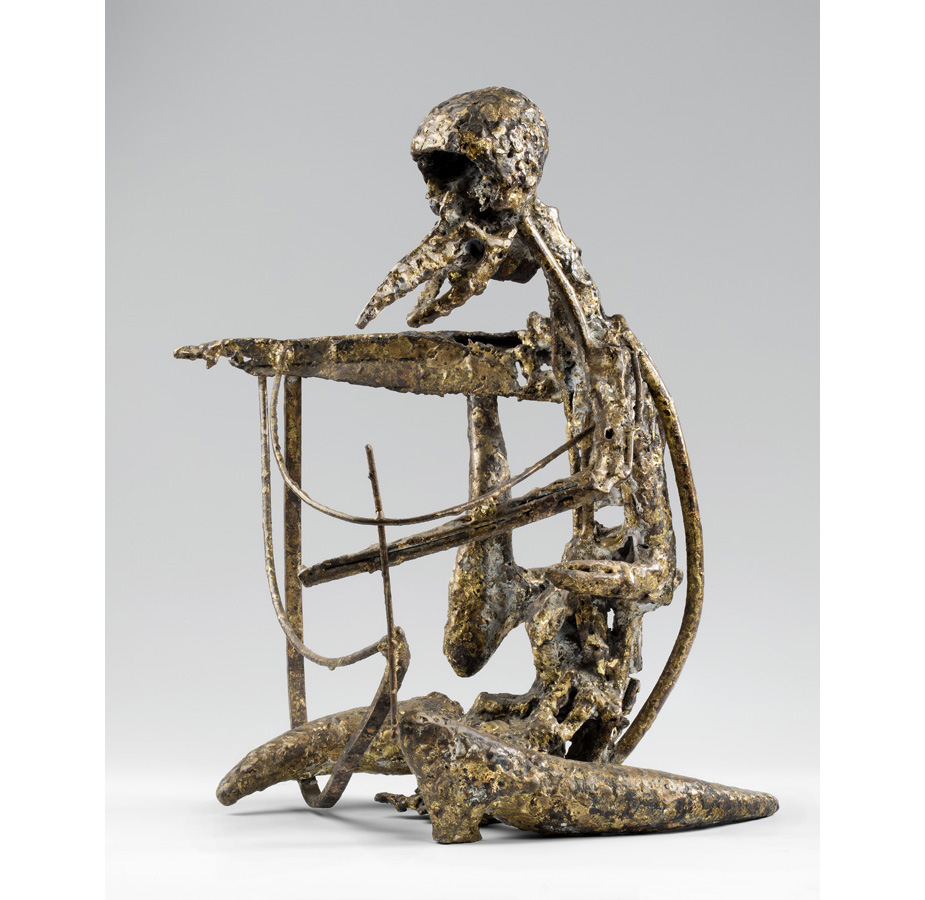
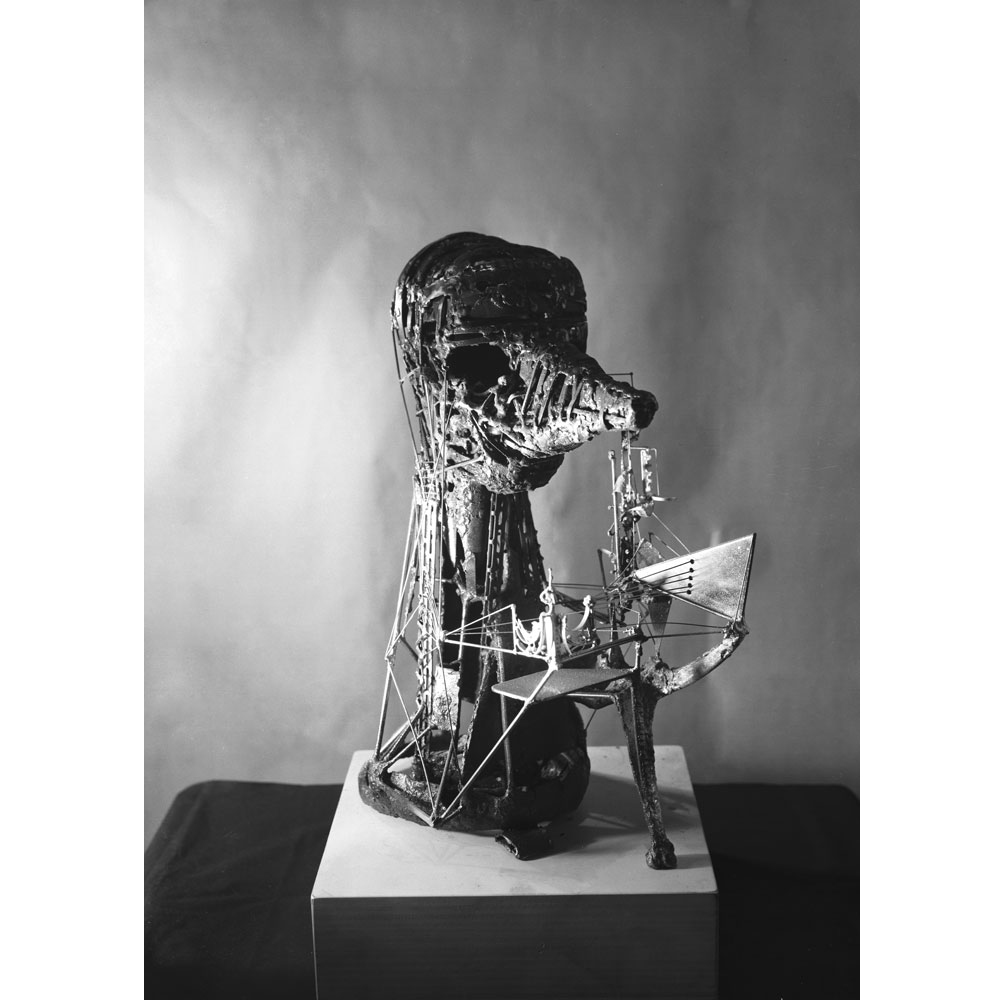
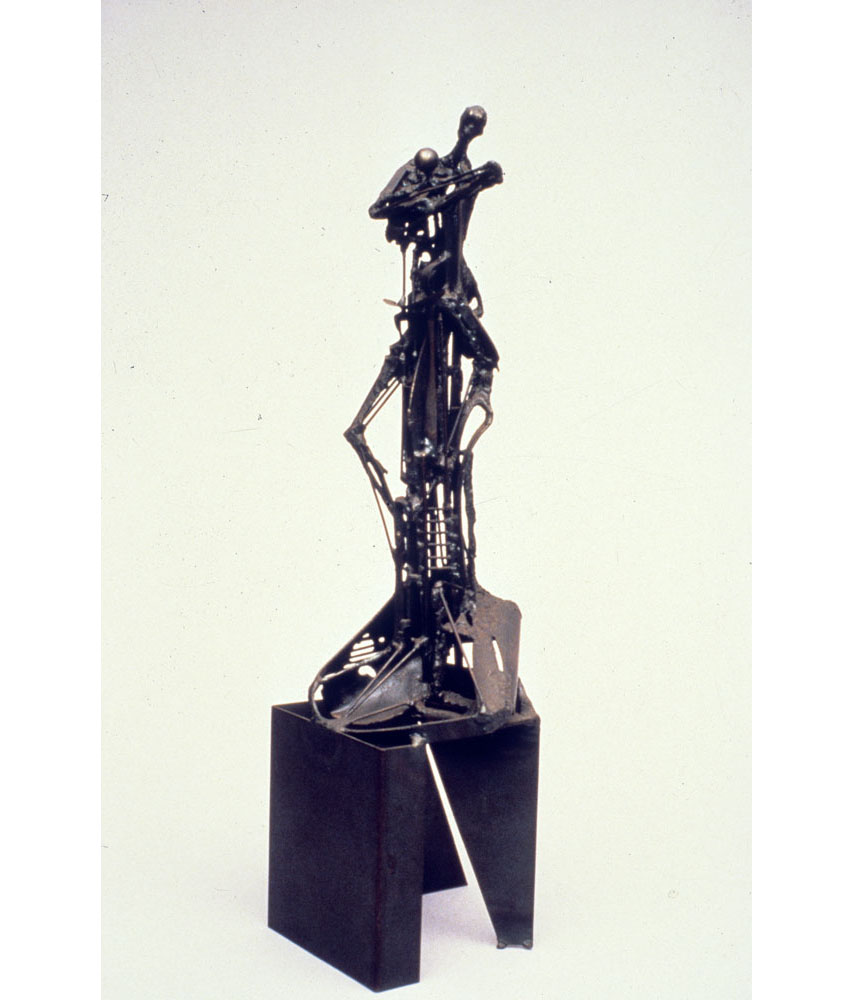
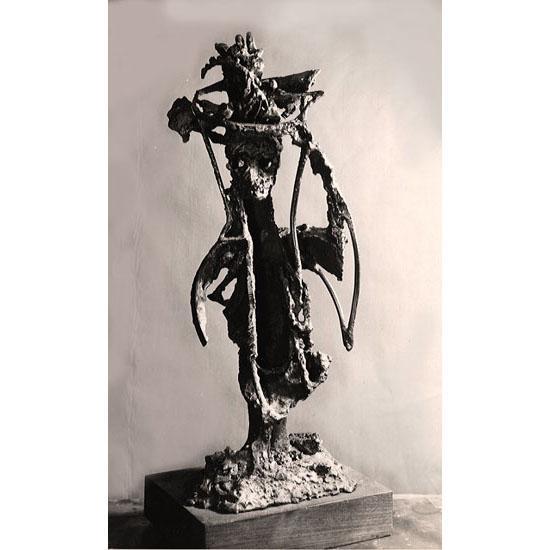
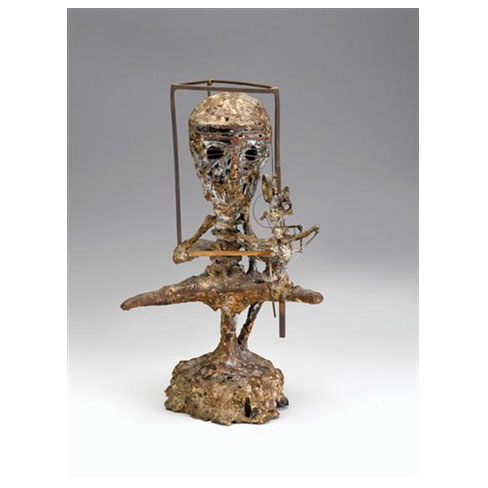
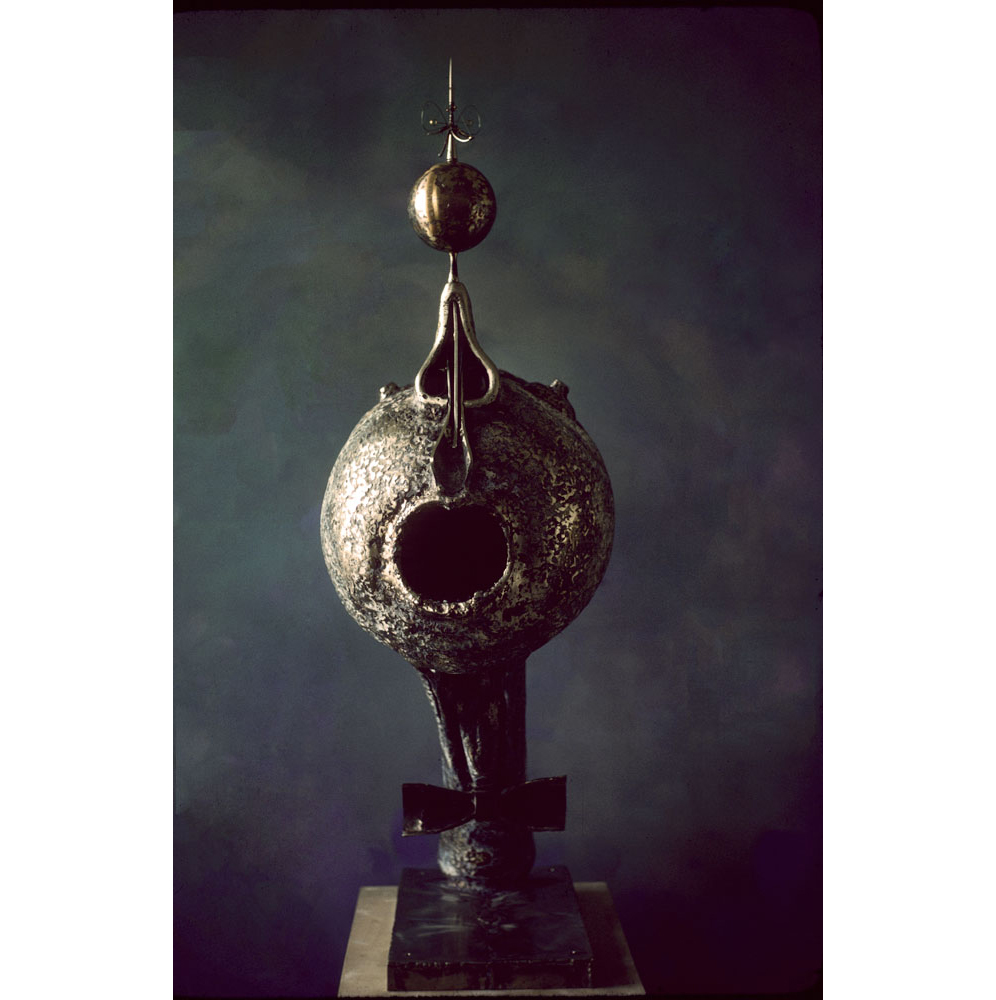
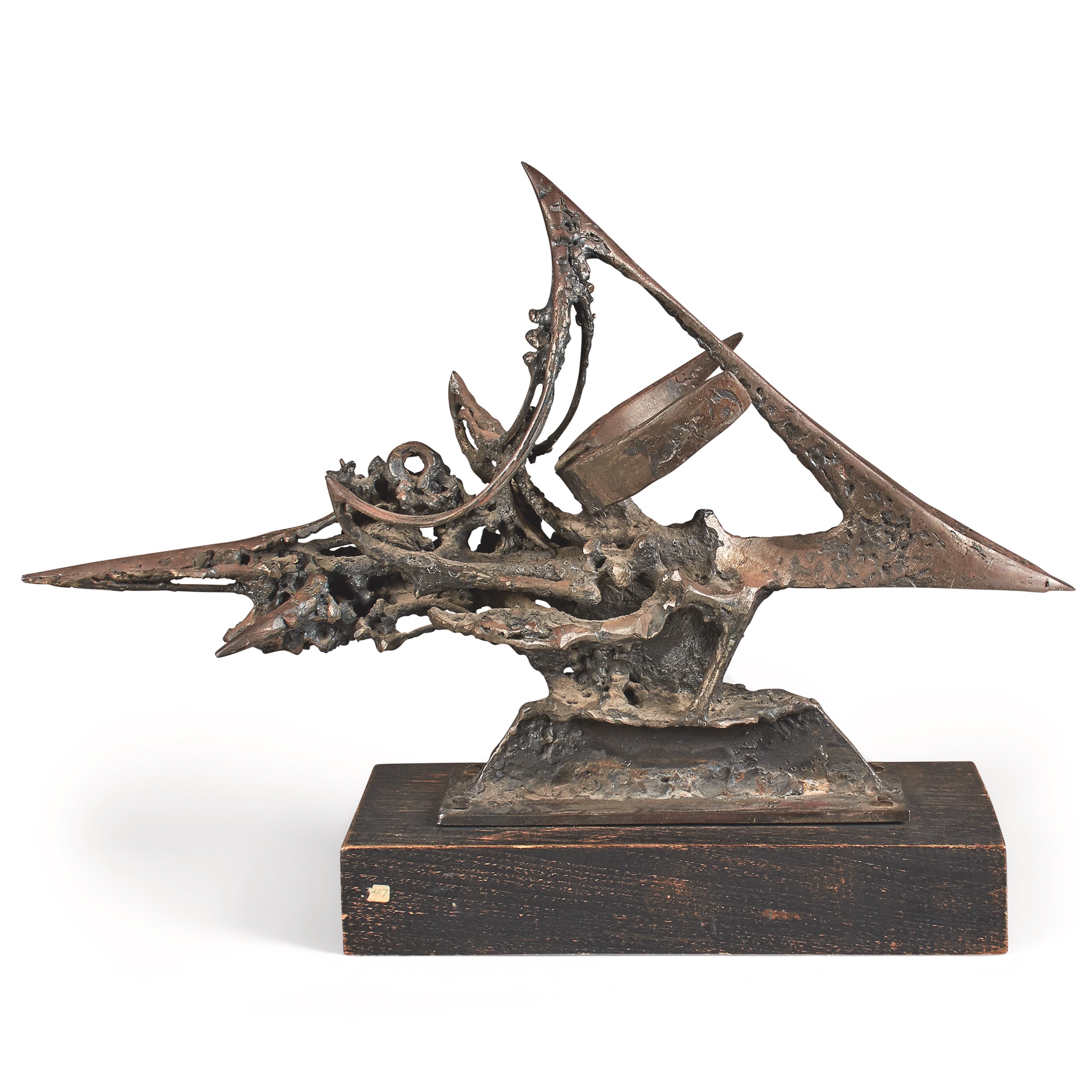
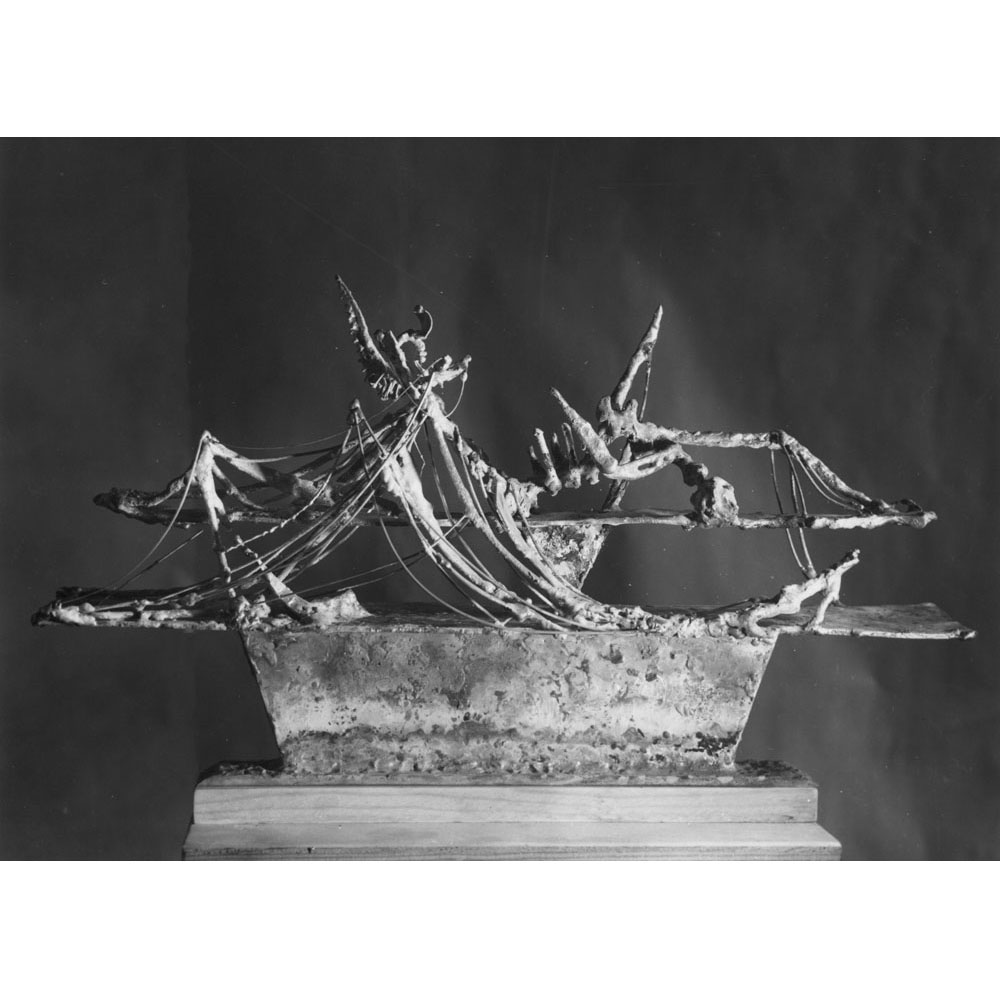
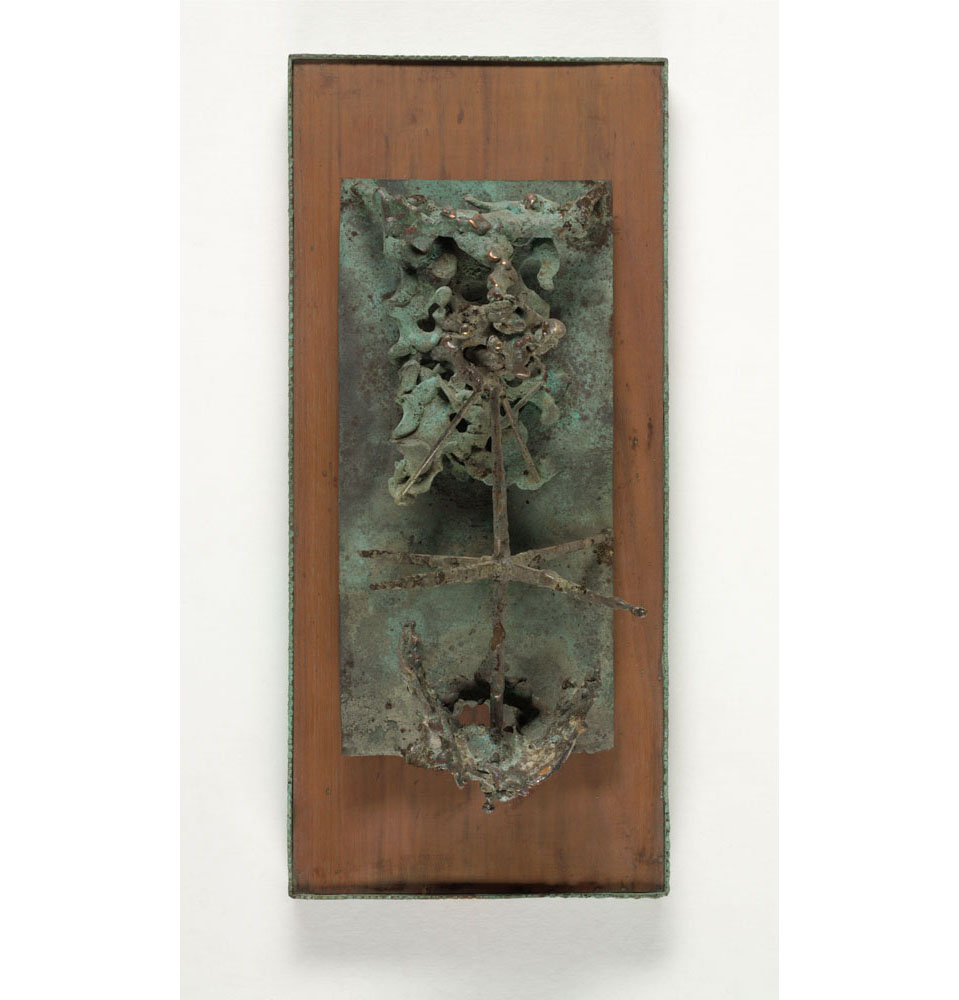
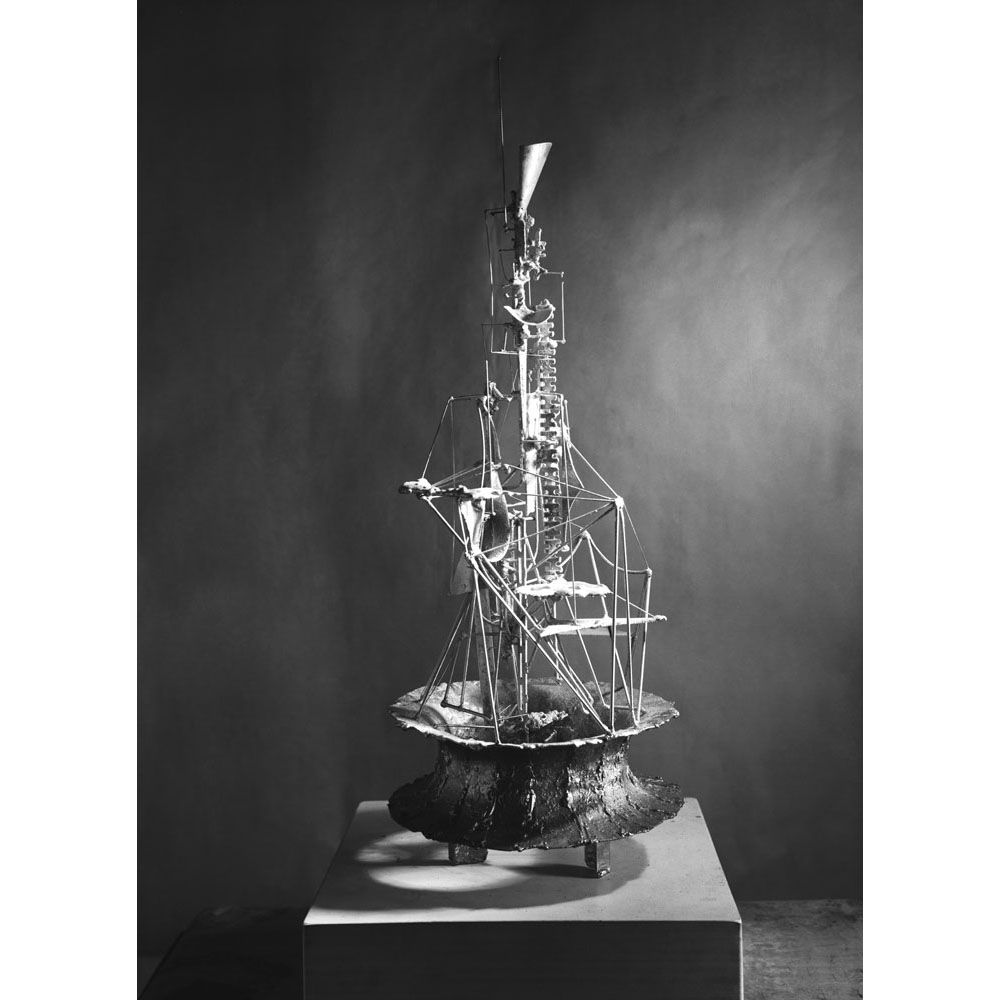
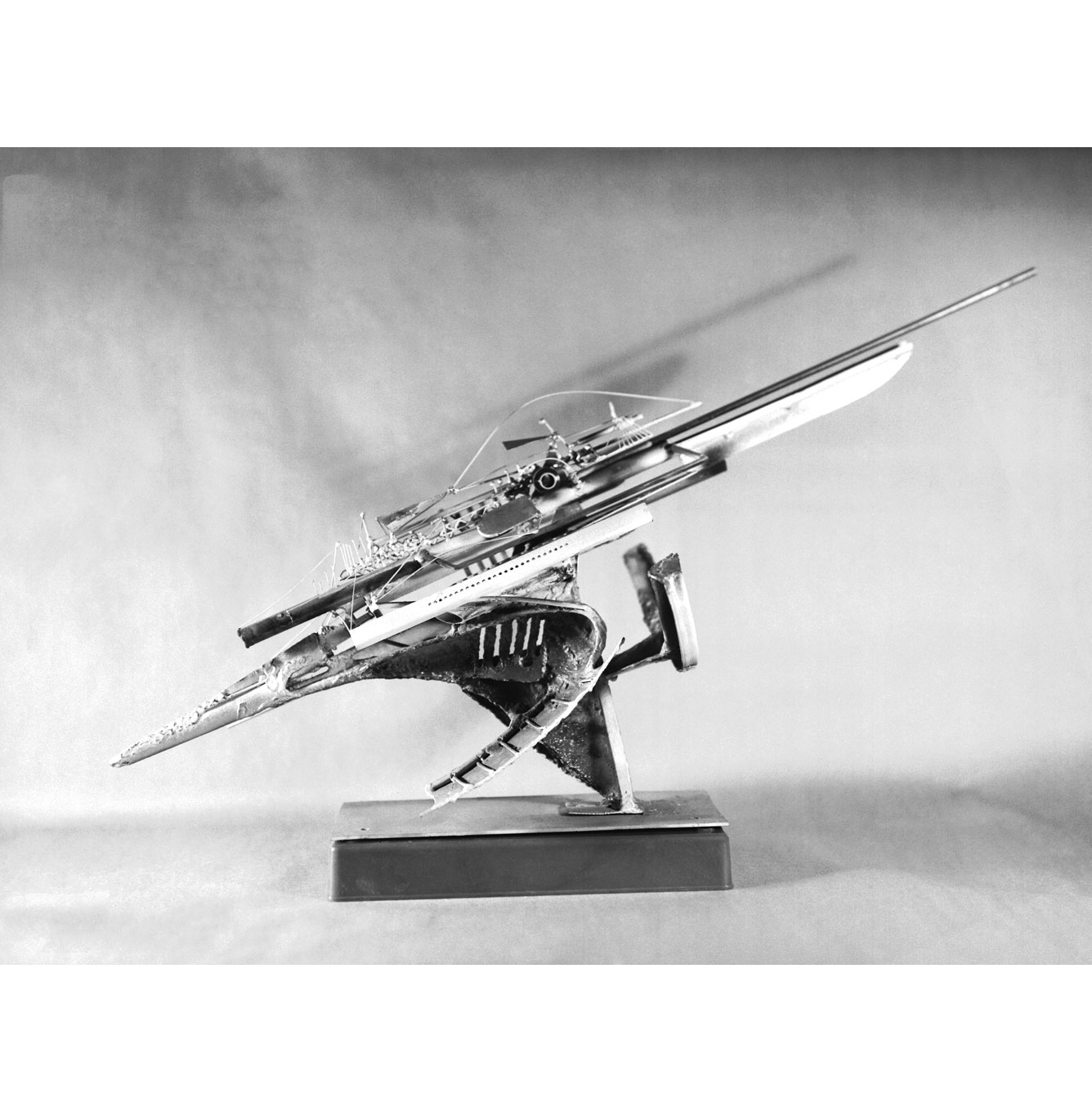
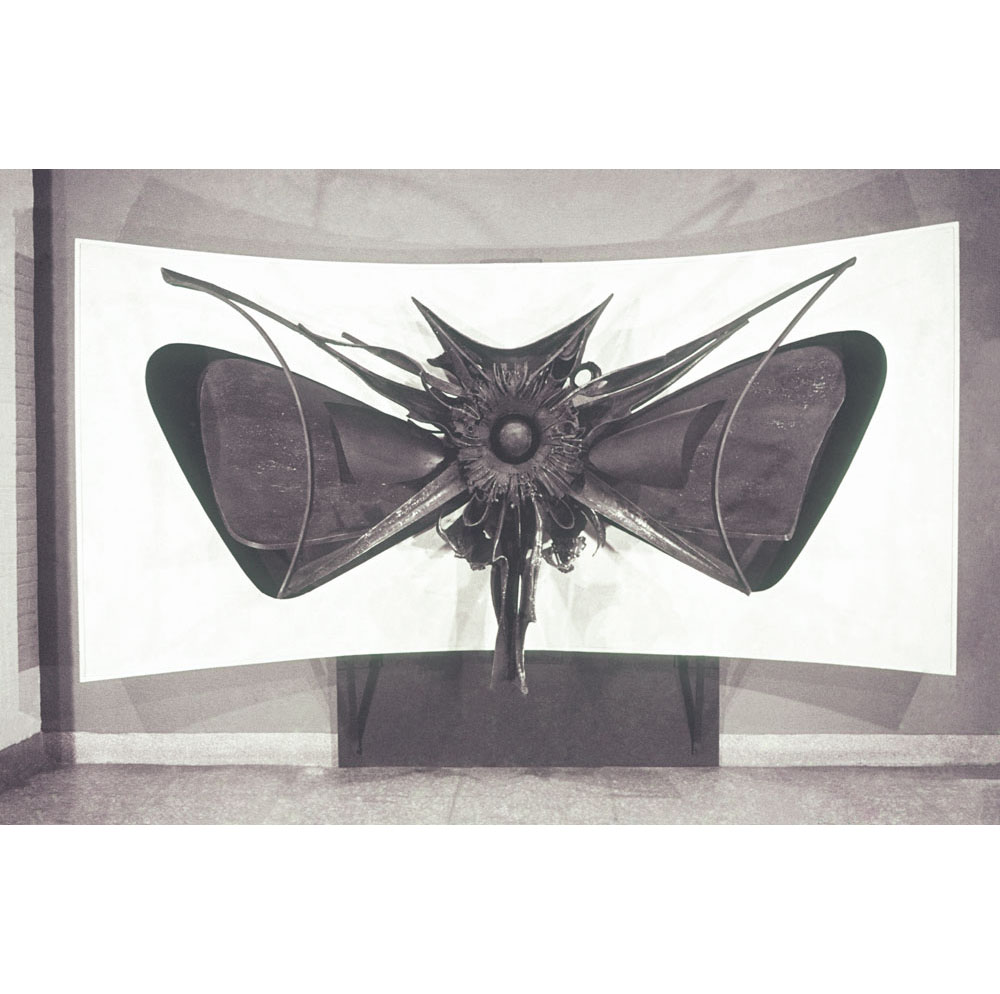
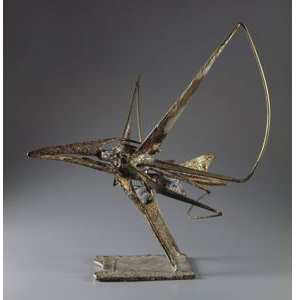
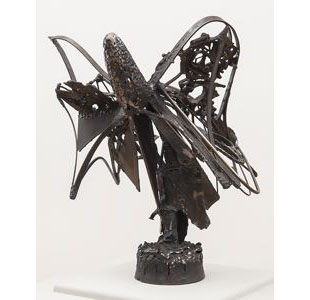
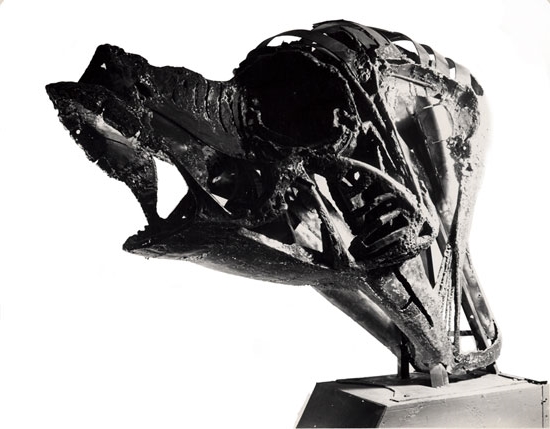
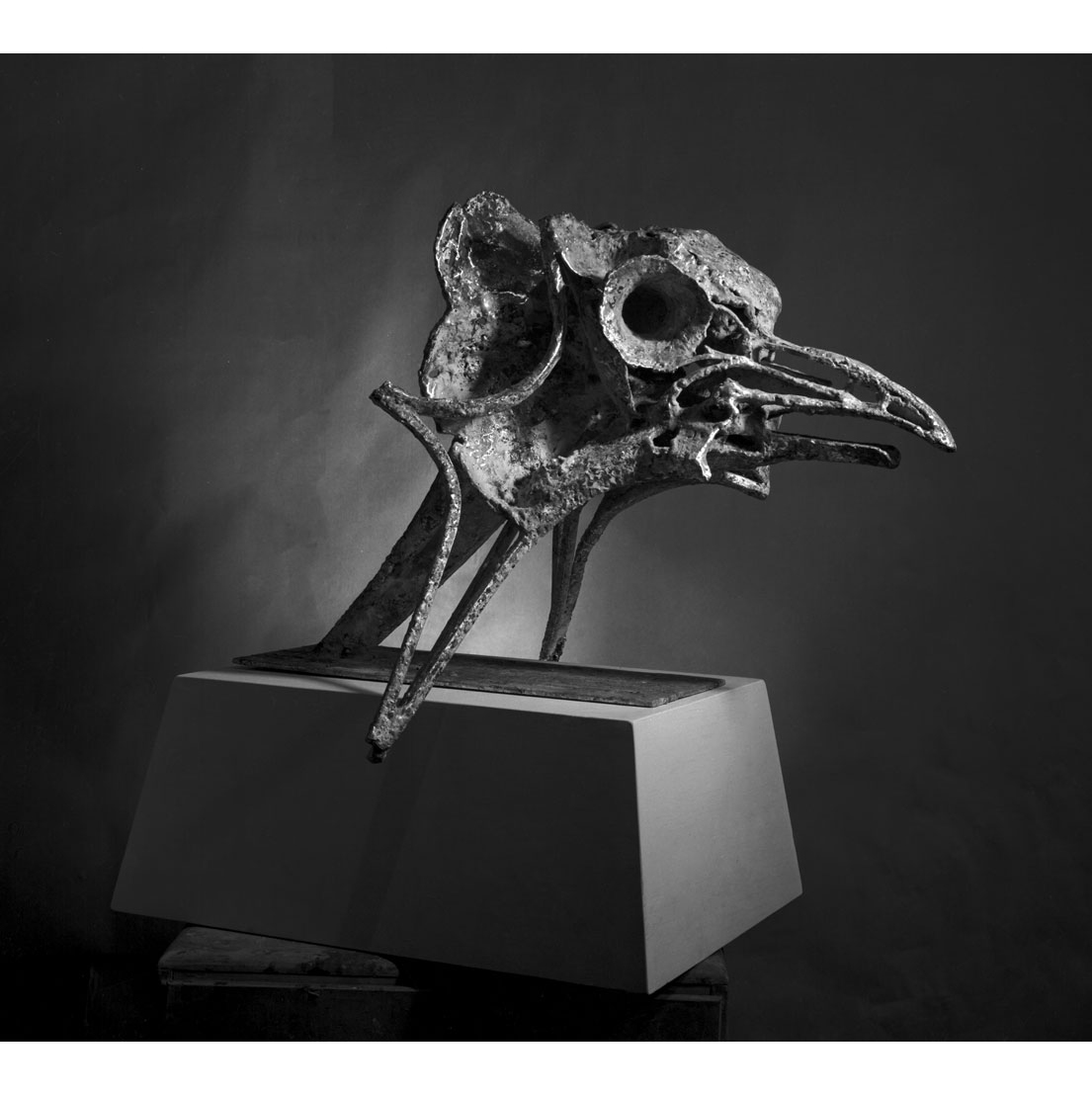
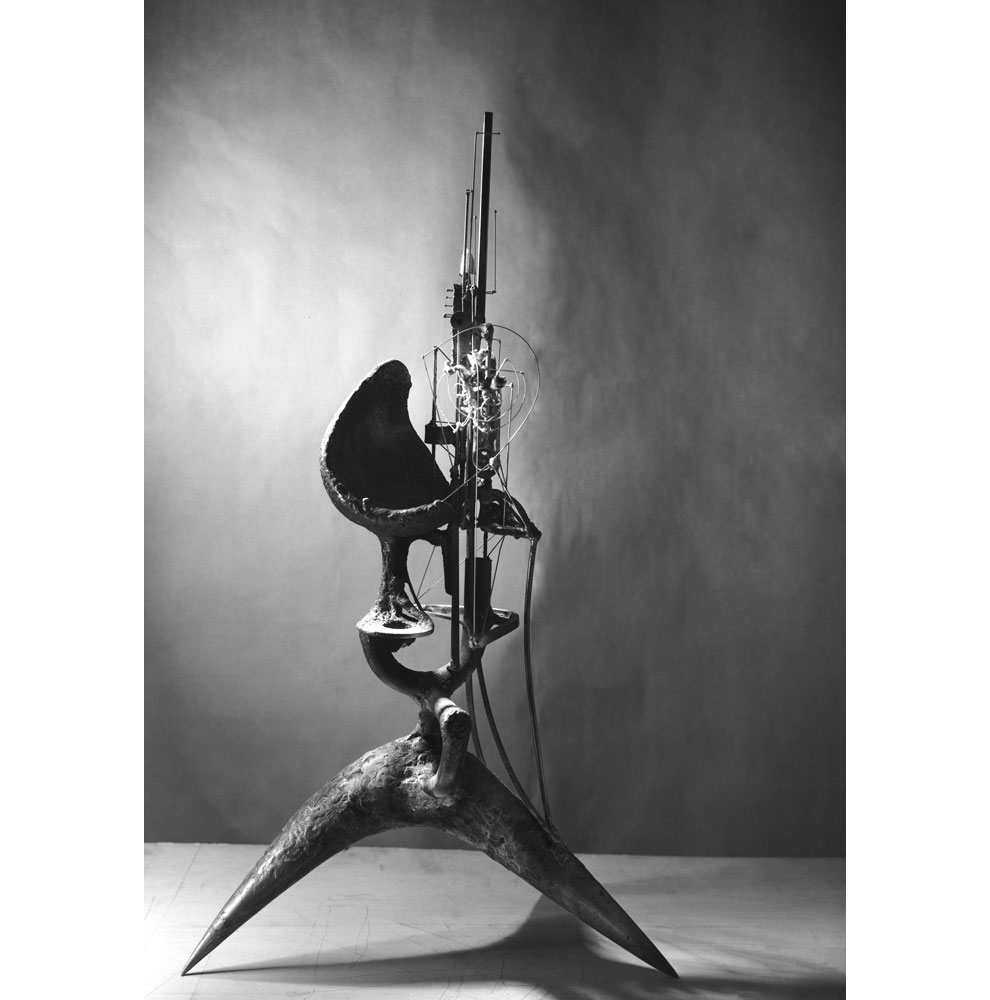
(1907-1981) First generation New York abstract expressionist artist
sculptor, painter, draughtsman
The first piece of sculpture after "Spatial Construction"
"I think the title is a little obvious but it is meant to be that, namely that is was a kind of growing out, and the first appearance of a form that I found to suggest itself as a result of that first spacial construction, in all of its irregularities. The forms themselves are ones that seem to indicate embryonic emergence." [Theodore Roszak Interview with Elliott, 1956, p.13]
Direct bronze, walnut base
17 1/2 x 20 x 9 1/2 inches (44.45 x 50.8 x 24.13 cm)
Collection: Arizona State University Art Museum. Gift of Oliver B. James (1951). Purchased from Pierre Matisse Gallery, NY.
Welded Steel
Location: Unknown
Welded Steel
Location: Unknown
Steel and brass
10.75 x 15 in
Location: Unknown
Bronze weldment with brown patina, unique
8 x 9.75 in (20.32 x 23.49 x 12.7 cm)
Location: Unknown
4 Variations: 1 Steel, 3 casted bronze
"In the Raven (1947) may be seen even more clearly the combination of evocative image, spatial movement, beauty of outline and textured surfaces which characterize so much of Roszak's sculpture. Here the shape implies not only the raven of Edgar Allan Poe, but the artist has also suggested a form of female symbol which he associates with the development of Poe's character. "
[H.H. Arnason, Theodore Roszak, The Walker Art Center, 1956]
"It was more or less motivated by the sensibility that Poe injects into the work, and I tried to see it as the brash kind of aggressiveness of that symbol and at the same time the psychological kind of symbolism of the female presence in this form, which had a very important role in the development of Poe's character." [Theodore Roszak Interview with Elliott, 1956, p.14]
Steel
18 x 24 inches
Collection: Theodore Roszak Estate and Private Collections
Bronze and wood
15.25 x 25 x 10.25 in (39 x 64 x 26 cm)
Location: Unknown
Pen and ink and wash on paper
4 15/16 × 6 15/16 in (12.5 × 17.6 cm)
Collection: Whitney Museum of American Art, NY. Gift of Mrs. Theodore Roszak (1979).
steel and brass brazed
10 x12 in
Location: Theodore Roszak Estate, NY.
"A wild passage from Melville's "Enchanted Isle" evoked "the wonder and beauty of devastation" and inspired the violent and predatory Sea Quarry."
[Belle Krasne, "A Theodore Roszak Profile", Art Digest, 1952.]
"Cape Ann, New England is where we spend most of our summers, and these shapes are commonplace during the sumer. I don't know if you are acquainted with that country, but this is the flora of sea life and the various crustaceans that abound in that area. By the way, the dry salvages are in that area, T.S. Eliot's,and that whole body of rock, because it is practically a piece of rock, reminds one very much of that same essential survival quality, excepting on another level, but there is nothing there, it is just rock, it is not very interesting, but when you look at it and think about it, it becomes quite beautiful. It is amazing how much real beauty one can find in a completely desolate and devastated area."
[Theodore Roszak Interview with Elliott, 1956, p.19]
Steel
30 1/2 x 38 x 25 1/2 inches (77.5 x 96.5 x 64.8 cm) on base
Collection: Norton Museum of Art, West Palm Beach, FL. Bequest of R. H. Norton (1953).
Pen and ink and wash on paper
28 1/4 x 39 3/4 inches (71.8 x 101 cm)
Collection: Norton Museum of Art, West Palm Beach, FL. Gift of the estate of Theodore Roszak (1986).
13 5/8 X 11 3/4 X 9 3/4 inches (34.5 X 29.8 X 24.6 cm)
Steel
Collection: Hirshhorn Museum and Sculpture Garden, Smithsonian Institution, Washington, DC. Gift of Joseph H. Hirshhorn (1966).
Ink on paper
14 x 10 inches (35.56 x 25.4 cm)
Collection: The University of Iowa Museum of Art. Purchase (1979).
Ink and wash on paper
13 7/8 x 10 in (35.24 x 25.4 cm)
Collection: Los Angeles County Museum of Art, California. Gift of the Estate of Theodore Roszak (2005).
"was made on the eve of the birth of the artist's daughter Sara Jane, and involves a highly personal emotion. The delicate and lovely flower which in order to survive must throw up a shield of thorns become a symbol of those many children whom war and destruction never permitted to develop."
[H.H. Arnason, "Theodore Roszak" The Walker Art Center, p.33, 1956]
"I made it on the eve of Sara Jane's birth and it was a kind of invocation of a gentle and beautiful floral structure that in order to survive would require the extension of thorns. It reminded me a little of the plight of many of the lives that were not fully developed or had the possibility of growth, particularly in Europe, and when Sara Jane was born I could not help but feel that same kind of plight and a desire on the part of her own development and survival in terms of acquiring these characteristics."
[Theodore Roszak Interview with Elliott, 1956, p.15]
Nickel-silver and steel
33 1/8 x 18 1/2 x 22 1/2 inches
Collection: Whitney Museum of American Art, New York. Purchase 1948.
Ink and opaque watercolor on paper
14 × 10 in (35.6 × 25.4 cm)
Collection: Whitney Museum of American Art, NY. Gift of the Theodore Roszak Estate (1983).
Gouache on paper
14 7/8 x 10 9/16 inches (37.78 x 26.83 cm)
Collection: Bowdoin College Museum of Art, Maine. Gift of the Theodore Roszak Estate (2010).
steel, copper, and brass
18 x 13.5 in
Location: Theodore Roszak Estate, NY.
Bronze, wood base
(77.3 x 92.8 x 65.4 cm; Base 77.3 x 93 x 65.4 cm)
Collection: Museo de Arte Contemporânea da Universidade de São Paulo, Brazil. [Incorporated into the MAMSP collection (1952). Donated to MAC USP (1963)].
1951 Purchase Award. São Paolo Biennal
Pen and wash on paper
Collection: CU Art Museum, University of Colorado Boulder, CO. Purchase (1954).
"Excepting the "Migrant" is not nearly as aggressive in external characteristics as the "Scavenger", though they are both formally intended to convey the same kind of restlessness and need for shifting positions. The "Migrant" may interest you in that it embodies more the characteristics of aircraft, as well as the organic forms of bird life. In other words, there is a more conscious use of man-made apparatus of a migratory nature than is indicated in the "Scavenger"."
[Theodore Roszak Interview with Elliott, 1956, p.15]
Steel brazed with copper
28 1/2 x 32 1/4 x 24 1/4 inches
Collection: University of Illinois Krannert Art Museum,University of Illinois at Urbana-Champaign. Purchased, Festival of Arts Purchase Fund (1953).
References:
"Theodore Roszak," Pierre Matisse Gallery, checklist., NY, no. 18, 1951.
Contemporary American Painting and Sculpture, cat., KAM, no. 104, pl. 53, p. 215, 1953.
Communicating Art from the Midwest Collections, Des Moines Art Center, IA, no. 86, 1955.
American Paintings and Sculpture 1948 - 1969. Urbana-Champaign, IL: Krannert Art Museum at the University of Illinois, Urbana-Champaign, 1971.
Metal
14 1/8 x 11 5/8 x 10 5/8 inches (35.9 x 29.6 x 27 cm)
Collection: Hirshhorn Museum and Sculpture Garden, Smithsonian Institution, Washington, DC, The Joseph H. Hirshhorn Bequest, 1981 (1986).
" The "Scavenger" is again like many of these contemporary allusions, a kind of shiftless migration of forces and at the same time ruthless on their way from one place to another. I think it in many ways embodies the restlessness that accompanies many of our contemporary migrations. It also has the parasitic characteristics that area common to the migratory personality, or you might even say the aggressive migratory nation." [Theodore Roszak Interview with Elliott, 1956, p.14]
Steel, bronze, and rock
14 x 18 x 12 in
Collection: University of Iowa Museum of Art. Gift of Dorothy Schramm.
"The Firebird is a mythic creature from Russian folklore; it was immortalized in the music of composer Igor Stravinsky in 1910. On hearing this music, Roszak said that he was inspired by the "smoldering chords that accelerate and then whip up into a terrific frenzy of sound." Like the Phoenix, the Firebird rises reborn from the fires of extinction; Roszak spoke of its "emergence out of a complete desolation…affirming life." This mythic creature becomes an allusion to the recurrence of the cycles of death and rebirth from ancient times to the post-World War II present."
[ Lisa Messinger, The Metropolitan Museum of Art, 1992.]
[Dreishpoon, Douglas, The Metropolitan Museum of Art, 2007.]
Iron brazed with bronze and brass
31 x 41 x 27 inches (78.7 x 104.1 x 68.6 cm)
Collection: The Metropolitan Museum of Art, NY. The Muriel Kallis Steinberg Newman Collection, Gift of Muriel Kallis Newman, in memory of the artist, 1982.
"It is Chinese, you know, it is a Chinese allusion. I came upon it from Stravinsky, the wonderful piece of music he has written around it, he has these slow smoldering chords that accelerate and then whip up into a terrific frenzy of sound. To me that was important, plus the fact that it has bearing on the other half of the world. It wasn't purely a local experience in even the European sense, but it embodied a kind of ritualistic experience that found its habitat in practically any part of the world that has lived long enough to go through this smoldering and phoenix-like emergence out of a complete desolation and affirming its position all over again in terms of affirming life."
[Theodore Roszak interview with Elliott, 1956, p. 20]
Pen, brush and ink, watercolor, and pencil on paper
28 7/8 x 35 in (73.3 x 88.9 cm)
Collection: The Metropolitan Museum of Art, NY. The Muriel Kallis Steinberg Newman Collection, Gift of Muriel Kallis Newman, in memory of the artist (1982).
Black ink on wove paper
14 3/4 x 20 inches (37.5 x 50.8 cm)
Collection: Wadsworth Atheneum Museum of Art. Hartford, CT. Gift of Belle K. Ribicoff (1991).
Ink
Collection: Chazen Museum of Art. Madison, Wisconsin. Terese and Alvin S. Lane Collection (2012).
Ink on paper
14 1/2 x 11 3/8 in (36.83 x 28.89 cm)
Collection: Los Angeles County Museum of Art, California. Gift of the Estate of Theodore Roszak (2005).
Welded steel
92 x 125 inches
Collection: Theodore Roszak Estate
Sepia and ink
11 3/4 x 17 3/4 inches
Collection: Chazen Museum of Art. Madison, Wisconsin. Terese and Alvin S. Lane Collection (2012 on loan).
Ballpoint pen
8 3/4 x 11 inches
Collection: Chazen Museum of Art. Madison, Wisconsin. Terese and Alvin S. Lane Collection (2012 on loan).
Pen and ink and ballpoint pen on paper
8 1/2 × 11 in. (21.6 × 27.9 cm)
Collection: Whitney Museum of American Art, New York; Gift of Mrs. Theodore Roszak 91979).
Watercolor and ink on paper
11 7/8 x 15 15/16 in (30.2 x 40.5 cm)
Collection: Phoenix Art Museum, Arizona (1981).
"The Spectre is the pterodactyl, an early denizen of the air both savage and destructive. Present-day aircraft has come to resemble this beast of prey, hence the re-incarnation of the pterodactyl at Kitty Hawk…." - Theodore Roszak
"No airplane or airplane part is recognizable in the piece, yet there is a soaring quality, a surging astronomic form that sweeps heavenward in a crescent from earth below; it suggests the realization of man's long urge to fly like a bird. Yet the spiky, jagged, tormented explosion of agonized form at its center reveals the corruption of Icarus' ancient dream and the Wright brothers' proud intervention, for in two horrible World Wars the airplane had become an instrument of mass destruction. " [ Wayne Craven, "Sculpture in America, From the Colonial Period to the Present", 1968]
"The abstract form alludes to the prehistoric pterodactyl image of evil reincarnated as the modern aircraft with its destructive connotations." [ Wayne Andersen, "American Sculpture In Process: 1930/1970", 1975]
Welded and hammered steel brazed with bronze and brass
40 1/4 x 18 x 15" (102.2 x 45.7 x 38.1 cm)
Collection: Museum of Modern Art, New York. Purchased 1950.
Awarded the Mr. and Mrs. Frank G. Logan Art Institute Medal in 1947.
"The whole idea here is that the aircraft has been used in a very destructive way and it recalled the superior dominance of the pterodactyl that at one time was also the scourge of the air and of the earth and is a kind of reincarnation of its evil intent, so therefore its visitation at Kitty Hawk was the embodiment again of the aircraft assuming the role of the pterodactyl. Except that here it was a case of man projecting his desires, rather than nature. That is why I called it the "Spectre", this visitation of force back to the same origin of flight, excepting that this was in terms of man-made possibilities rather than in the natural evolution of the species." [Theodore Roszak Interview with Elliott, 1956, p.16]
Pen, brush and ink, and ink wash on paper
Irregular: 29 3/8 x 33 1/16 inches (74.6 x 83.9 cm)
Collection: Hirshhorn Museum and Sculpture Garden Smithsonian Institution, Washington D.C. (1966).
Ink and wash
57 1/8 x 42 1/2 inches
Collection: Chazen Museum of Art. Madison, Wisconsin. Terese and Alvin S. Lane Collection (2012).
"I have visited my mother in the southwest--she lives there for her health-- and it was an opportunity to see Texas and get acquainted with the environs of San Antonio. I observed these various cactus specimens around that vicinity and this one was largely determined by the century plant that blooms every one hundred years and at night. That gives you a sense of the delicacy of the structure. If it were to bloom during the day it would just shrivel up. It took a century for that to occur and what I was fascinated by were all the environmental accouterments of this plant life, really very menacing, very tough and hardy and could perhaps survive any number of circumstances that even a hardy plant could never quite cope with, then suddenly after a century it gives out with this beautiful bloom at night. It is quite a moving thing to experience."
[Theodore Roszak, Interview with Elliott, 1956, p. 19]
Welded steel
30.62 X 49.75 x 22.5 in (77.77 X 126.36 x 57.15 cm)
Private Collection
Provenance:
Gift of Arnold H. Maremont to the Art Institute of Chicago
ink and pencil on paper
10.8 x 14 inches (27.4 x 35.6 cm)
Collection: National Museum Warsaw, Poland.
Ink on paper
8 13/16 x 11 3/4 in.
Collection: Chazen Museum of Art. Madison, Wisconsin. Terese and Alvin S. Lane Collection (2012).
Steel
14 x 13.5 x 6.75 inches; base is 11 x 5.5 x 2 inches
Location: Private Collection
Pen and ink on paper
10 1/16 x 24 3/8 inches (510 x 619 mm)
Location: The Morgan Library & Museum, NY. Gift of Sara Jane Roszak, Estate of Theodore Roszak (2007).
steel brazed with copper
29 x 14.25 in
Location: Unknown
silver and nickel
35 x 18 x 21 in (88.9 x 45.72 x 53.34 cm)
Location: The Rose Art Museum, Brandeis University, MA. Gift of Herbert Agoos, Andover, NH (1987).
"The tremendous impact upon him (Roszak) of Melville's Moby Dick finally crystallized in the concept of the pursuer and the pursued who ultimately become one. An anvil in his forge seen in half darkness suggested the shape that his concept must take and out of these elements emerged one of his most moving, suggestive, and forceful sculptures. "[H.H. Arnason, Theodore Roszak, The Walker Art Center, 1956]
"Melville is a very unique personality and it is the kind of work that he has done and the way in which he lived and how he resolves the conflicts of his life that attracted my attention. Since "Moby Dick" perhaps is a work that most clearly characterizes these conflicts and the resolution of them, that were a part of Melville's life and a part of America, I felt this to be a work that more vividly conjured up visual associations than any other." [Theodore Roszak Interview with Elliott, February 13, 1956, p. 27]
Exhibition History:
The Art Institute of Chicago's "Object & Image in Modern Art & Poetry",1954
Yale Gallery of Art, May 1953; Whitney Museum, NYC, April 1953
Penn. Academy, 1951
Steel
34.5 x 45.5 inches, approx 525 lbs.
Collection: The Art Institute of Chicago. Edward E. Ayer Endowment in memory of Charles L. Hutchinson (1954-1958). Purchased from Pierre Matisse Gallery in 1954.
Pen and black ink, with white gouache, on white wove paper
8.7 x 6.2 inches (22.3 x 15.8 cm)
Collection: The Art Institute of Chicago. Gift of Theodore Roszak (1955).
Pen and black ink on ivory wove paper
14 x 10 inches (35.4 x 25.3 cm)
Collection: The Art Institute of Chicago. Gift of Theodore Roszak (1955).
India ink applied with pen and brush, and colored washes on white wove paper
13 15/16 x 10 1/16 inches (35.4 x 25.5 cm)
Collection: Worcester Art Museum, MA. Gift of the Estate of Theodore Roszak (1985).
"The mandrake is a reputedly poisonous and narcotic plant, usually found growing in the Mediterranean area, although one form of it is found throughout the northern zones of Europe and America. It grows with forked roots causing it to bear a touch resemblance to the human figure, and it is fabled to emit a terrifying shriek as it is torn from the dart. Both its appearance and its narcotic and poisonous reputation established a prominent place for it in old chronicles of magic and witchcraft." [ The Bulletin of the Cleveland Museum of Art, November 1964.]
Steel brazed with copper
64.70 x 101.60 x 29.80 cm (25 7/16 x 40 x 11 11/16 inches).
Collection: The Cleveland Museum of Art. Gift of the Cleveland Society for Contemporary Art, 1964
"It is very much like Baudelaire's "Flowers of Evil" in that sense, and it indicates pretty much the kind of fruition that can develop even from evil intentions. We have the flowering of destructive forces on a par with even constructive ones. It was done at a period when all of these evil characteristics in society were taking on all kinds of extensions and influence and power. We need not assume that evil necessarily is always something that is on the way out, but it is constantly with is and can prow in any given situation that is propitious to its development. This is a kind of legendary recapitulation of that same evil force found in the contemporary situation when it was done." [Theodore Roszak Interview with Elliott, 1956, p.12]
Pen and brown ink and brown wash
Collection: The Cleveland Museum of Art, Ohio (1964).
welded steel
20 in
Location: Unknown
Nickel silver brazed onto steel
58 3/4 x 28 1/2 x 28 1/2 in. (149.225 x 72.39 x 72.39 cm)
Collection: Pennsylvania Academy of the Fine Arts, PA. Henry D. Gilpin Fund (1968).
Pen and ink and gouache on paper
38 x 25 inches (965 x 635 cm)
Location: The Morgan Library & Museum, NY. Gift of the Estate of Theodore Roszak (2014).
steel brazed with copper
46 1/2 x 23 x 17 in
Location: Theodore Roszak Estate, NY.
Steel
Location: Unknown
Versions (4): 1 Welded Steel, 2 bronzes, and 1 small welded steel.
"Roszak's 'Skylark', a poem in shining steel of a figure alive with motion, half-bird, half-human, pivoting on tiptoe in the act of taking flight, with a burst of stars for a face."
[W.Norris Clark, "New Images of Man" exhibition at MOMA NY in 1959, America National Catholic Weekly Review vol. CII No.8, 1956.]
"Inspired by a poem of Gerard Manley Hopkins which refers to the "chained skylark", it "reflects the plight of man descended from his Promethean heights, caught within the bonds of civilization, and reduced to the ashes of his own bones." Roszak also sees in this image of Icarus descending in flames."
[H.H. Arnason, Theodore Roszak, The Walker Art Center, 1956]
Exhibition History:
Pierre Matisse Gallery, New York (1956)
Whitney Museum, NYC, 1952
Sculpture Center 25th Aniversary exhibition, 1953
"New Images of Man", MOMA, NY, 1956
Welded Steel
H: 99 inches
Collection: Theodore Roszak Estate
Bronze
H: 99 inches
Collection: Ulrich Museum of Art, Kansas, Wichita State University. (1978)
ink on paper
8 1/2 x 5 3/8 inches (21.6 x 13.7 cm)
Collection: Ulrich Museum of Art at Wichita State University, Kansas (1994).
Ink
11 15/16 x 8 7/8 inches
Collection: Chazen Museum of Art. Madison, Wisconsin. Gift of Barbara Mackey Kaerwer (1991).
Welded steel
34.5 x 16x 11.75 inches
Collection: Yale University Art Gallery, CT. Gift of Stephen Carlton Clark, B.A. 1903 (1954). Purchased from Pierre Matisse Gallery.
"The "Rite of Passage" is very much like the allusion to the gargoyle. the gargoyle was a kind of symbol of protection and defiance toward external evil forces. In many ways the meaning of the "Rite of Passage" is a kind of ritual which tests the individual as to his right to walk over the threshold without being prepared for the next problem in this psychic development. This is a symbol of guards at that threshold to see that one does not make that step unless one works through."
[Theodore Roszak Interview by James Elliott, 1956, p. 24]
nickel silver brazed on steel
50 1/2" x 26" x 13" inches
Collection: Theodore Roszak Estate
" "The Guardian of the Sea" brings together Roszak's interest in mythology with a specific historical event, the American bombing of Japanese waters. Roszak saw the bombing as an attack on nature that must have destroyed "millions of specimens of sea life." This destruction recalled for the artist myths of a "sea king" who protected the marine world. This legend of an amphibian sentinel inspired Roszak's image, but contemporary events motivated its creation: "My concern was to recreate this guardian of the seas, this sentinel of the seas for all the destruction that has happened as a result of our atomic war that not only destroyed life, but polluted the waters." (Theodore Roszak)" [Joan Marter, "Mythic Visions: Theodore Roszak's Works on Paper", p.25]
Brazed Steel
Height: 105 inches (266.7 cm)
Collection: Whitney Museum of American Art, New York; Purchased (1956).
Pen and ink on paper
8 9/16 × 11 in. (21.7 × 27.9 cm)
Collection: Whitney Museum of American Art, New York; Gift of Mrs. Theodore Roszak (1979).
Ink
10 15/16 x 14 inches
Collection: Chazen Museum of Art. Madison, Wisconsin. Terese and Alvin S. Lane Collection (2012 on loan).
Graphite and ink
13 15/16 x 10 7/8 in.
Collection: Chazen Museum of Art. Madison, Wisconsin. Terese and Alvin S. Lane Collection (2012 on loan).
Steel
Location: Unknown
Steel, Silver, and copper
Location: Unknown
Steel
Location: Unknown
"The Invocation series represents a more ambitious attempt to translate and interpret fundamental ideas concerning the meaning of life. Invocation I (1947) is an overt and violent symbol of sex and fertility, an invocation to life and survival. Invocation II (1950-51), using chalice and candelabra forms, suggests the nature of and the need for spiritual life; while Invocation III…attempts to combine the spiritual and physical elements in terms of the salient characteristics of his sculptural forms. "
[H.H. Arnason, Theodore Roszak, The Walker Art Center, 1956]
Steel
30 3/8 x 21 3/4 x 14 1/4 inches (77.2 x 55.2 x 36.2 cm)
Collection: Hirshhorn Museum and Sculpture Garden, Smithsonian Institution, Washington, DC, Gift of Joseph H. Hirshhorn, 1966. Purchased from Pierre Matisse Gallery, New York 1961.
"This is the first of the series of pieces that have to do with invoking the whole symbol and meaning of life, and here we have a kind of crude sense of wild forms and forms that survive under a dire circumstance and somehow manage to integrate into a mature structure. A lot of these forms I have seen in my travels in the southwest where they abound on the prairie of that part of the country. The fecundity, of course, here is emphasized by the obviously female symbolism and the fruitful kind of effusion that follows in the wake of any kind of fruition, and these are the protecting devices ensnaring it into an almost involuntary desire to perpetuate the species. It is a kind of invocation to life, depending upon the most extreme means of survival in order, at any expense, to protect its species and produce its own prototype." [Theodore Roszak Interview with Elliott, 1956, p.16-17]
Pen and ink and watercolor on paper
18 x 11.75 in (45.7 x 29.8 cm)
Collection: Hirshhorn Museum and Sculpture Garden Smithsonian Institution, Washington D.C. (1977).
Ink and watercolor on paper
18 X 11 15/16 in (45.8 X 30.3 cm)
Collection: Hirshhorn Museum and Sculpture Garden, Smithsonian Institution, Washington, DC (1977).
"There is a kind of reference to ecclesiastic form here (there is the candelabra, and there is a kind of chalice form), so that in many ways this invokes a kind of spiritual requirement and association, rather than the survival characteristics in the "Invocation I" series. What I have done in the three is to try to see all of these put together and to symbolize a quality that gets outside even of the third category. It perhaps embodies most of the forms that I have done in this one structure."
[Theodore Roszak Interview with Elliott, 1956, p.17]
Steel
19 inches
Collection: Eli and Edythe Broad Art Museum, Michigan State University. Purchased by MSU 1959.
Pen, ink and watercolor wash on rough wove paper
14 1/16 x 10 inches
Collection: Eli and Edythe Broad Art Museum, Michigan State University. Gift of the Estate of Theodore Roszak (2005).
Black and gray ink, gray and brown wash, and graphite on cream wove paper
11 5/16 x 14 7/16 inches (28.8 x 36.6 cm)
Collection: Harvard Art Museums/Fogg Museum. Cambridge, MA. Margaret Fisher Fund (2006)
"The first one deals with physical survival and the second has much more emphatic direction toward the spiritual survival of human qualities and in "number III" I would like to embody both of these, plus the salient characteristics of the forms of all the work that I have done. So that it becomes a total experience based upon the physical and the spiritual and the creative qualities expressed in this one idea. It is a kind of organismic evolution of varying levels of survival characteristics and I don't think it would be complete if it merely began and ended with the first one." [Theodore Roszak Interview with Elliott, 1956, p.18]
Copper alloy (nickel silver) and steel
67.5” x 41.75”
Collection: David Owsley Museum of Art, Ball State University, Munci, IN. Place on loan by David P. Owsley (2009).
Pen and ink, brush and ink, wash, and charcoal on paper
Irregular: 92 5/8 × 42 1/8 in (235.3 × 107 cm)
Collection: Whitney Museum of American Art, NY. Gift of the Theodore Roszak Estate (1983).
Pen and ink on paper
68.5 x 42.5 inches
Collection: David Owsley Museum of Art at Ball State University, Muncie, IN. Placed on loan from David T. Owsley (2009).
Steel and nickel silver
113 3/4 × 58 1/2 × 17 3/8 in. (288.9 × 148.6 × 44.1 cm), with base.
Collection: Whitney Museum of American Art, New York; Gift of the artist in honor of John I. H. Baur. 1974.
Aluminum
26 x 15 x 11 in (without base) (66 x 38.1 x 27.9 cm)
Location: Virginia Museum of Fine Arts, Richmond, VA. Gift of Reynolds Metals Company (1986).
"The upward thrust of the forms is intended as an invocation, a reverence for life, and the thinner curvilinear strands not only act aesthetically as a visual foil for the larger and more aggressive forms, but metaphorically they suggest the mantle, drape, or veil which are symbolic of both honor and humility." [Theodore Roszak interviewed at the time of the R.S. Reynolds sculpture award ceremony in 1957].
"It is the symbol at the threshold, and of course is largely taken from the great work that Francis Thompson did. That was his own plight. I felt his own search for spiritual identity recaptured it in the adult experience… his lost cause is very much like the plight of the knowing, intelligent and sensitive man today who cannot quite reconcile himself to institutional practice, but at the same time is in need of spiritual experience and desires, and he is caught in the limbo and a kind of suspended, neutral position of desiring and not ever attaining. That was exactly the position of Thompson."
[Theodore Roszak Interview by James Elliott, 1956, p. 24]
Steel with nickel-silver and copper
6' 2" x 20 3/8" x 27 1/8" (188 x 51.8 x 69 cm)
Collection: Museum of Modern Art, New York. Gift of the Estate of Theodore Roszak (1983).
Steel
Location: Unknown
welded steel
20 1/4 x 15 x 9 1/2 in
Location: Theodore Roszak Estate, NY.
"…the conflict in Sullivan was again symbolized by a flower like the thistle. I think this was really no accident, he was attracted to something Setoch in his ancestry, or even the motive closely related to Ireland by geographical proximity; it really has nothing to do with the real quality of conflicts that occurred in the man, and reaching out for symbols, he found that this could express it as well as anything else." [Theodore Roszak Interview with Elliott, February 13, 1956, p.28]
cut and welded steel
41 3/8 x 40 1/2 x 30 inches (105.2 x 102.9 x 76.3 cm)
Collection: Smithsonian American Art Museum, Washington D.C. Gift of the Sara Roby Foundation (1986).
black and brown Ink and wash on paper on cream heavy textured cold pressed wove
21.75 15 inches
Collection: David Owsley Museum of Art, Ball State University, Muncie, IN (2006).
Pen and brown ink on paper
11 × 8 1/2 inches (27.9 × 21.6 cm)
Collection: Whitney Museum of American Art, New York; Gift of Mrs. Theodore Roszak (1979).
Ink with wash on paper
10-7/8 x 15-1/8 inches
Collection: Palmer Museum of Art at Penn State University, PA. Purchased with funds from the Terra Art Enrichment Fund (2005).
" I thought that the monumental aspect of a project of this kind would have to be affirmative. I couldn't believe that a man imprisoned and held prisoner, hostage, against his own desires could give rise to the same kind of objective monumentality as a man who would be perfectly willing to sacrifice himself for his political belief. When I wrote to Sir John about this, I tried to point out that where everyone tried to stress the negative aspects of the theme of the political prisoner, they had all kinds of bars and forms of incarceration, which are negative aspects, even though they are probably true. To me it was necessary to give it this thrust of defiance, and then the wings and flourish of triumph. Therefore, the sub-title consideration to the whole theme of the political prisoner in this case became one of defiance and triumph, actually standing up for one's political beliefs."
[Theodore Roszak interview with Elliott, 1956, p. 22-23]
Joan Marter, "The Ascendancy of Abstraction for Public Art", Art Journal, Winter 1994, Vol. 53 No.4.
Steel
371 x 476 x 229 mm
Collection: Tate Museum, London, UK. Purchased (1953).
Pen, ink and sepia wash on paper
25 1/2 x 42 1/4 in. (64.8 x 107.3 cm)
Montclair Art Museum, New Jersey Collection. (2004)
drawing, ink, indian ink on paper
27.4 x 33.7 inches (69.7 x 85.6 cm)
Collection: National Museum Warsaw, Poland.
1951
Ink and wash
10 15/16 x 13 7/8 in.
Collection: Museum of Chazen. Madison, Wisconsin. Terese and Alvin S. Lane Collection (2012 on loan).
Pen, ink, and wash on paper
12 1⁄4 x 10 inches (311 x 254 mm)
Location: The Morgan LIbrary & Museum, NY. Gift of Sara Jane Roszak, Estate of Theodore Roszak (2007),
"The Titan, Prometheus, 1956 - who stole fire from the gods to give to man, who saw the future and suffered Zeus' vengeful anger for it- sparks an abstract sculptural tribute. Diagonal thrusts and crescents surrounding starbursts teeter in precarious bilateral symmetry, the conceptual invocation of this giant. In this modern form they renew the ancient story and revitalize its message."
"The "Prometheus" series will of course deal largely with the sun, and fire, and relate itself more directly to man. It gets down the essential origins, water, fire, rock, ground, stars and movement. It is that kind of reiteration of those basic qualities."
[Theodore Roszak interview with Elliott, 1956, p. 20-21]
Steel brazed with nickel-silver
Height: 15 inches.
Collection: Hort Family Collection, NY.
steel and bronze
40 x 23 in
Location: Unknown
Versions: 3 welded steel
"According to Roszak, the title of the work refers to the birth of his daughter Sara Jane in 1947, while content derives from his memories of her childhood:
"At the age of two, she had several dreams in which she saw a cradle in the stars. She'd tell me about this object that she clearly saw and we'd work at it and then she'd tell me more, and I'd work more at it and this is the result. Something of the exploding star form has appeared in this, too…Children ask extraordinary questions, sometimes not wanting an answer. One night at Cape Ann, my daughter turned to me and asked: "Why is the moon so sharp?" and this reminded me of other naive and anxious questions she had asked, such as " We do have the biggest army in the world, don't we, daddy?" Later, out of this, came a sudden desire on my part to create something that would embody, side by side, the soft probing quality of the child-mind and the terrible menace that surrounds it everywhere." (Theodore Roszak)" [-Lucy Flint-Gohlke, Walker Art Center: Painting and Sculpture From the Collection, 1990]
"I drew this when Sara Jane was a child and she would tell me about this cradle she would see in the heavens and the stars, and I thought it would be a very nice kind of memento of an experience that any parent would share, and at the same time her own drawings of this were very stimulating and fresh and had the embodiment of this very simple idea of a cradle or a lullaby." [Theodore Roszak Interview with James Elliott, 1956, p. 28]
Steel and bronze, 52 x 32 x 14 inches (132.1 x 81.3 x 35.6 cm)
Location: Solomon R. Guggenheim Museum, NY. Gift, Mr. and Mrs. Arnold H. Maremont (1959).
Purchased from Pierre Matisse Gallery in 1959.
The New York Times Front page with Prime Minister Jawaharlal Nehru admiring the sculpture (1960).
Sculpture on left: Méditation avec bras, 1881 by Auguste Rodin
"Exposition Internationale de Sculpture Contemporaine", June 22- October 15, 1956.
This was the first international sculpture exhibition at the Rodin Museum in Paris.
India ink, brush (wash), pochoir on paper
13 in. x 16 in (33.02 cm x 40.64 cm)
Location: Bowdoin College Museum of Art, Brunswick, Maine. Gift of the Theodore Roszak Estate (2010).
steel brazed with copper and silver-nickel, 96 in. x 66 in. x 47 1/2 in. (243.84 cm x 167.64 cm x 120.65 cm)
Location: Currier Museum of Art, Manchester, NH. Museum Purchase. The Henry Melville Fuller Acquisition Fund (2004).
Steel, bronze
64 11/16 × 21 9/16 × 35 3/16 inches
Location: Walker Art Center Minneapolis Sculpture Garden, MN. Gift of the T.B. Walker Foundation (1960).
Welded and brazed steel, black painted patina, partially polished
24 x 11 x 10.5 inches
Collection: David Owsley Museum of Art, Ball State University, Muncie, IN. Purchased (2006).
Ink on paper
10” x 8”
Collection: David Owsley Museum of Art, Ball State University, Muncie, IN (2006).
ink on paper
24” x 18”
Collection: David Owsley Museum of Art, Ball State University, Muncie, IN (2006).
Steel
24 in height
Location: Unknown
Welded steel
Height: 111 in
Location: Private Collection, MA.
Welded steel and copper
19.6 in
Location: Unknown
Steel
55 x 24 in
Location: Theodore Roszak Estate, NY.
Steel
39 x 25 in
Location: Theodore Roszak Estate, NY.
Steel
86.5 x 24 in
Location: Private Collection
Steel
5 x 4 x 2 9/16 in (12.7 x 10.2 x 6.5 cm); 17 1/16 in (43.4 cm) Base:
Location: Williams College Museum of Art, MA. Bequest of Jane T. Ritchie (1985).
cast, steel covered with bronze
22 x 15 x 16 inches (55 x 39 x 41 cm)
Collection: National Museum of Art Warsaw, Poland. Gift of Sara Roszak.
Ball-point pen and watercolor on handmade paper
18 x 12 inches (45.5 x 30 cm)
Collection: National Museum of Art Warsaw, Poland. Gift of Sara Roszak.
Steel
18.5 in
Location: Theodore Roszak Estate, NY.
steel and copper
22 x 13 in
Location: Theodore Roszak Estate, NY.
Steel and bronze
15.9 x 9.4 x 8.6 in (40.3 x 23.8 x 21.9 cm)
Location: Unknown
steel and nickel silver
40 in
Location: Theodore Roszak Estate, NY
steel and silver nickel
12 x 21.5 in
Location: Private Collection, MD.
Steel
22 in
Location: Theodore Roszak Estate, NY.
Steel
9 x 12.5 in
Location: Theodore Roszak Estate, NY.
"a huge figure in steel and aluminum relief that is at once a butterfly, a strange flower, and an ominous royal presence. Describing Roszak's insect sculptures in the introduction to the catalog of his 1962 one-man exhibition, Lionel Abel wrote, " Roszak makes bugs that are metamorphosed into themselves…They are at large, they unfold like the most delicate blossoms, they are like musical instruments-often they are like music."
Painted Steel
69 x 107 x 26 1/2 inches (175.3 x 271.8 x 67.3 cm)
Collection: Theodore Roszak Estate
Steel, brass, silver-nickel, and paint
23 x 24 inches
Collection: Chazen Museum of Art at University of Wisconsin-Madison. Terese and Alvin S. Lane Collection (2012).
Ink and wash
8 3/8 x 11 in.
Collection: Chazen Museum of Art. Madison, Wisconsin. Terese and Alvin S. Lane Collection (2012 on loan).
Ink and wash
9 7/8 x 14 1/16 in.
Collection: Chazen Museum of Art. Madison, Wisconsin. Terese and Alvin S. Lane Collection (2012 on loan).
Welded steel
21 x 19 7/8 x 18 15/16 inches
Collection: Chazen Museum of Art at University of Wisconsin-Madison. Dr. C. V. Kierzkowski Fund purchase (1968).
Ink
14 1/8 x 11 in.
Collection: Chazen Museum of Art. Madison, Wisconsin. Gift of Theodore Roszak (1968).
"It breaks out again in a violent cry in the tremendously dynamic "Iron Throat" of the American Roszak, a great eroded skull in steel plate and tubing, its mouth open in an enormous shout-an image, one cannot help but think, of the power of communications: all voice, but dead within."
- W.Norris Clark on "New Images of Man" exhibition at MOMA NY in 1959. (America National Catholic Weekly Review vol. CII No.8)
Exhibition History:
Pierre Matisse Gallery, NYC, year.
"New Images of Man" Exhibition, Baltimore Museum of Art & MoMA, NYC, 1959.
Venice Biennale (30), Italy, 1960.
Darmstadt, Germany, 1963.
Museum of 20th Century Art, Vienna, Austria, 1964.
Whitney Museum of American Art, NYC, 1969.
University of Art Museum, University of California, LA, 1970.
Steel
42 x 54 inches
Collection: Theodore Roszak Estate
Steel and bronze (gold surface)
24 x 30 in
Location: Theodore Roszak Estate, NY.
"The welded and brazed metal assemblage, Singing Heart, also by Roszak, dates from 1969, nine years after the first preliminary drawing for the piece. As seen in the later watercolor, it was originally intended as a large fountain group. According to Roszak, the sculpture "defies the supremacy of the 'monolith' sculpture (closed form)) and asserts the 'open' form by puncturing the mass full of a variety of 'holes'- meaning that we see not only on the surface of the forms but through it as well." (Theodore Roszak to Floyd Amsden, 2-3-77) Roszak was able to envisage many of these same formal considerations in his earlier drawings, and yet the scale of the fountain suggests a more monumental arrangement.
[Douglas Hyland, From "Drawings to Sculpture: The Creative Process at White Gallery Spencer Museum University of Kansas.]
Welded steel and nickel-silver metal
23.75 x 13.5 inches (60.3 x 34.3 cm)
Collection: Ulrich Museum of Art - Wichita State University, Kansas.(1995).
Public Collections:
Arizona State University Art Museum, AZ
Baltimore Museum of Art, MD
Chazen Museum of Art at University of Wisconsin-Madison, WI
Currier Museum of Art, Manchester, NH
David Owsley Museum of Art, Ball State University, Munci, IN
Eli and Edythe Broad Art Museum, Michigan State University, MI
Hirshhorn Museum and Sculpture Garden, Smithsonian Institution, Washington, DC
MIT List Visual Arts Center, MA
Museo de Arte Contemporânea da Universidade de São Paulo, Brazil
Museum of Modern Art, NY
National Museum of Art Warsaw, Poland
Norton Museum of Art, West Palm Beach, FL
Pennsylvania Academy of Fine Arts, PA
Smithsonian American Art Museum, Washington D.C.
Solomon R. Guggenheim Museum, NY
Tate Museum, London, UK
The Art Institute of Chicago, IL
The Cleveland Museum of Art, OH
The Metropolitan Museum of Art, NY
The Rose Art Museum, Brandeis University, MA
University of Illinois Krannert Art Museum, University of Illinois at Urbana-Champaign, IL
University of Iowa Museum of Art, IA
Ulrich Museum of Art, Kansas, Wichita State University, KS
Virginia Museum of Fine Arts, Richmond, VA
Walker Art Center Collection, Minneapolis, MN
Williams College Museum of Art, MA
Whitney Museum of American Art, NY
Yale University Art Gallery, CT